We would love to hear your dystonia story. If you’re interested in sharing your story with us, it could be included in an upcoming newsletter or e-newsletter.
Read on for some of the latest stories of persons with Dystonia below.
Muscle groups affected: Throughout the body
- Jennifer Lovell: DMRF Canada Support Group Leader
"You may not see it but there’s a war going on inside my body."
– Jennifer Lovell, Winnipeg, MBJennifer Lovell is our Winnipeg Support Group Leader and a courageous member of the dystonia community. Jennifer's journey with dystonia has been filled with challenges, but it is also a testament to her resilience and determination to advocate for better awareness and treatment of this condition. Here, Jennifer candidly shares her story in the hope of inspiring others and driving change in the dystonia community.
To read about Jennifer’s journey with dystonia, please visit: https://dystoniacanada.org/jenniferlovell- Shelby Newkirk: Canadian Paralympic Athlete
 Shelby Newkirk’s journey as a Paralympic swimmer and entrepreneur is a true testament to her resilience, determination, and passion. From representing Canada on the world stage to balancing her personal and professional pursuits, Shelby has consistently pushed boundaries, achieving greatness along the way.
Shelby Newkirk’s journey as a Paralympic swimmer and entrepreneur is a true testament to her resilience, determination, and passion. From representing Canada on the world stage to balancing her personal and professional pursuits, Shelby has consistently pushed boundaries, achieving greatness along the way.Shelby’s hard work in the pool led to a major milestone when she won a bronze medal in the 100m backstroke at the Paris 2024 Paralympic Games. Her journey to this accomplishment was paved with dedication, including a silver medal performance at the 2019 Para Swimming World Championships and her Paralympic debut in Tokyo 2021
To read more about Shelby’s journey with swimming while navigating dystonia, please visit: www.dystoniacanada.org/shelby
- Brenda Lewis: A Twisted Fate - My Life With Dystonia
My Life With Dystonia, by Brenda Currey Lewis
 Brenda Currey Lewis was a typical, active child. But when she was seven years old in 1974 her life changed dramatically. Generalized dystonia turned her muscles against her. With her mom's unwavering advocacy, she has navigated the unchartered waters of this baffling disorder Brenda started walking on the outer edge of her right foot, and within a year she was wheelchair bound. The symptoms gradually spread through most of her body. For almost forty years Brenda has experienced uncontrollable muscle movements that have wreaked havoc in her body, but not her spirit.
Brenda Currey Lewis was a typical, active child. But when she was seven years old in 1974 her life changed dramatically. Generalized dystonia turned her muscles against her. With her mom's unwavering advocacy, she has navigated the unchartered waters of this baffling disorder Brenda started walking on the outer edge of her right foot, and within a year she was wheelchair bound. The symptoms gradually spread through most of her body. For almost forty years Brenda has experienced uncontrollable muscle movements that have wreaked havoc in her body, but not her spirit.This is a story of resilience in the face of a little-known, confusing, and debilitating condition. Brenda’s quirky sense of humour makes this candid account of life with dystonia a thought-provoking and an entertaining read.
Brenda was the president of the Edmonton Dystonia Support Group for twelve years and is still involved in raising funds and lending guidance to newly-diagnosed dystonia patients. She wrote A Twisted Fate to raise awareness about dystonia, and she looks forward to the day that medical researchers find a cure for this unwelcome intruder. To order A Twisted Fate contact Brenda Lewis.
Podcast Episode
Brenda Currey Lewis: A Twisted Fate - My Life With Dystonia on "It's A Wrap with Rap"
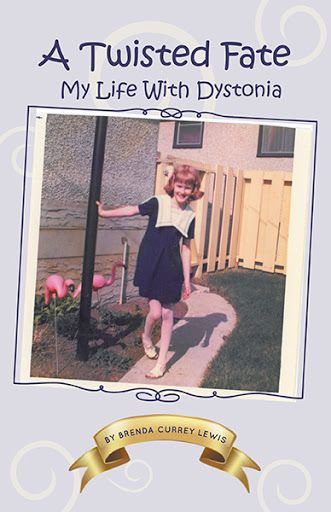
- Sarah Anderson: DMRF Canada Teen Ambassador
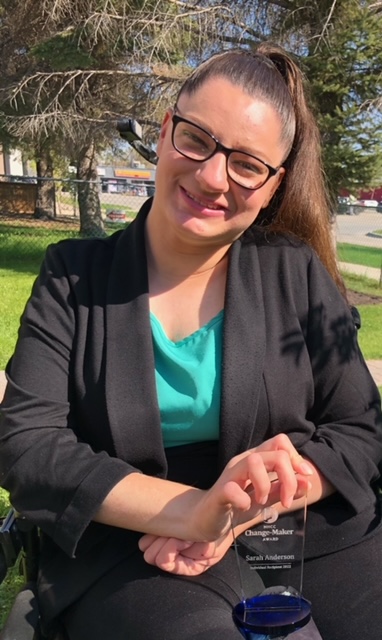
2022 NCCC Changemaker Award: News Release
2022 NCCC Changemaker Award: Sarah's Acceptance Speech
My journey with Dystonia, though unknown at the time, began the very day I entered the world. As part of a complicated birth, I was born not breathing and for the first several minutes of my life doctors worked hard to clear my lungs. After an extended period, they were finally successful. However, it was a happy moment that would soon be accompanied by some life changing news. Just days after my birth the doctors informed my parents that I had suffered brain damage due to a lack of oxygen. My official diagnosis was Cerebral Palsy (CP), a non-progressive condition characterized by impaired muscle coordination and potential cognitive challenges. The only symptom that initially led doctors to believe I had CP was the fact my left hand was clenched tightly to my chest. As an infant, some of my milestones were either delayed or never met, which seemed to prove the accuracy of my diagnosis.
It was not until my pre-teen years that I, along with my family, noticed significant changes in my symptoms and abilities. I could no longer use a walker, something that I had been capable of since I was a toddler. In addition, my tremors progressed throughout my body and my legs started twisting to the left. These worsening symptoms convinced doctors to change my diagnosis to Generalized Dystonia. With this new discovery, I embarked on a medical journey exploring a variety of medications in hopes to reduce and control the associated symptoms and pain. This was all new to me, as for the first twelve years of my life I had never taken medication in relation to my disability.
Being a pre-teen at the time I must admit that I was more concerned about the future than I was about the present. One of the first questions I asked my doctor was, “How fast are my symptoms going to progress?” He responded, “Every case is different so there is really no way of predicting that.” Though I deeply craved a more promising response, I knew that I had to accept that some answers are only revealed with the passing of time.
At that point, I also could not help but wonder if my dreams for the future were actually realistic. Despite living with a disability, I was always that typical child who wanted to grow up and attend university, pursue a career, and one day have a family. With that in mind, my first major goal was to graduate high school at age eighteen. However, the pain associated with my Dystonia hampered my ability to attend school full time. Suddenly it seemed like the task that I once saw as achievable was now slipping from my reach. Knowing my desire to succeed academically, in my seventh year some adaptations were set in place with the help of my family and my school. Through working on assignments at school as well as at home, I was able to keep up with the course material.
It seems so surreal that all this happened five years ago. Although I still cannot attend school full time, I am currently a grade twelve honour roll student on track to graduate at the end of the school year. In effort to further my passion for academics, I plan to attend university and pursue a career in education. As a small step toward this goal, I enjoy volunteering at Manitoba Children’s Museum. Through my Dystonia diagnosis I have also realized the importance of advocacy. In the fall of 2016 I became an ambassador for the Rick Hansen Foundation. As part of their school program, I do presentations to students expressing the importance of accessibility and the inclusion of those living with disabilities.
If there was one thing I could say to other teens living with Dystonia, it is to never give up on your goals. We may not always have control over our symptoms, but how we choose to live with them will forever remain in our hands. Always remember that whether positive or negative, every aspect of our lives helps to guide us on a journey to become who we are truly meant to be.
-Sarah Anderson, Teen Ambassador for the DMRFC
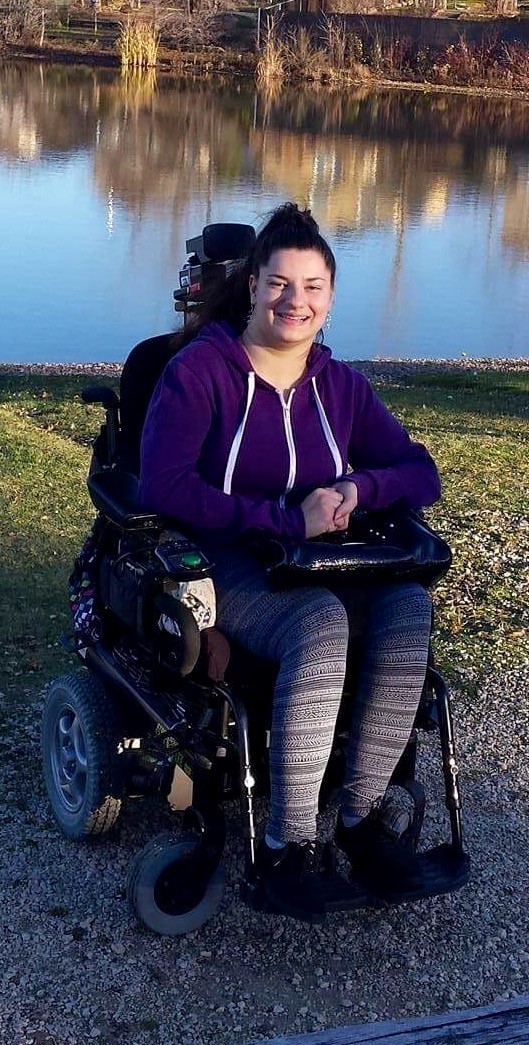
- Neil Merovitch: The First Ever Recipient of the Jackson Mooney Patient Grant
We are thrilled to announce that DMRF Canada has awarded the first ever dystonia patient grant. The 2017 Jackson Mooney Patient Grant was established to provide financial assistance of up to $5,000 for Canadian residents who are living with dystonia, in financial need and committed to enhancing their current situation through furthering their education.
“My personal experience, and that of many others with dystonia, is that it can profoundly impact our ability to execute some, many, or all of our work tasks in as timely and focused a manner as we enjoyed prior to the affect of the disease. This grant is aimed at helping in a small way, this particular aspect of our journey” -Jackson Mooney, who established this grant in partnership with his brother Jefferson.
Click here to read on about Neil’s dystonia surgery, featured in the Canadian Association for Neuroscience webpage here.
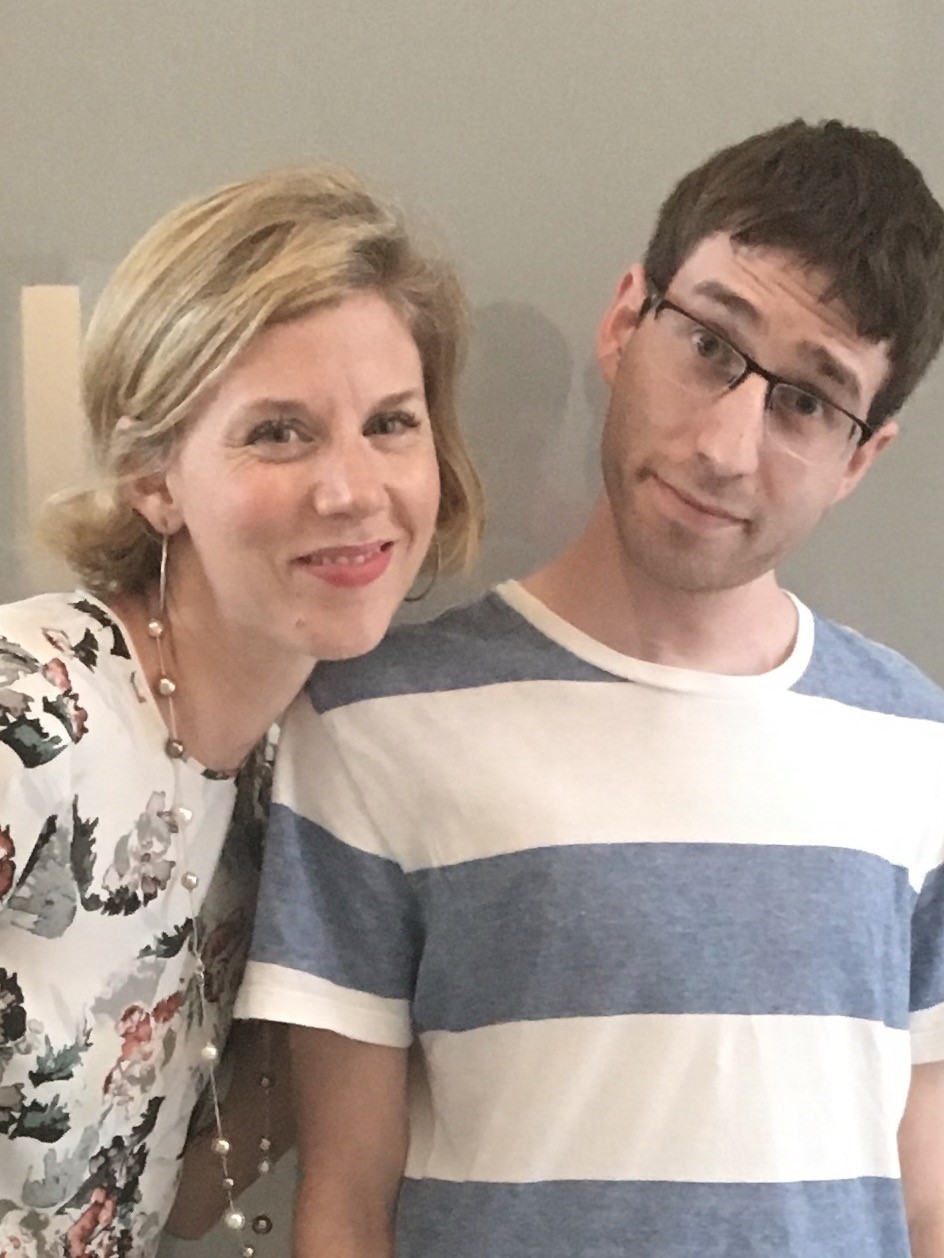
Recipient Neil Merovitch with former DMRF Canada Executive Director Stefanie Ince
Our first grant recipient Neil Merovitch. Neil was diagnosed with Cervical Dystonia at the age of 7, and later his diagnosis becomes generalized dystonia. Though he has faced numerous challenges, Neil has proven to be an outstanding scholar and a true example for others suffering from dystonia. Neil completed his undergraduate degree at the University of Dalhousie and pursued his Ph.D. in molecular genetics at the University of Toronto. In his words, “This grant would help greatly in supporting my continued education; it would allow me to dedicate my time to studying neurodevelopment with the hopes of finding treatments and cures for neurological conditions':
Our thanks to all applicants, and a special thank you to Jackson Mooney and his brother Jefferson, both who generously came up with the idea for the grant, and have committed to funding this on an annual basis.
Neil recently was interviewed by writer Julie Soudat for the "Faces of Temerty Medicine" about his experiences as an advocate, doctoral student, and living with a disability. Click here to read his interview.
- Julie Trant
“Two Generations, One Hope: Be Part of the Cure for Dystonia”
Julie’s story is one of resilience, family strength, and the urgent need for progress in dystonia research. Diagnosed with childhood-onset generalized dystonia, she spent years navigating pain, stigma, and the uncertainty of a life shaped by a rare neurological disorder. Decades later, her world shifted again when her young son began showing even more severe, rapidly progressing symptoms of the same genetic condition. Their journey led them across the globe for life-changing Deep Brain Stimulation (DBS) surgery—first for her son, then for herself—transforming both of their lives. Today, Julie and her family are advocates for research, awareness, and hope, committed to helping ensure that every person living with dystonia has access to effective treatments and, one day, a cure.
Read the full story about Julie's Journey with Dystonia Here.

Cervical Dystonia (Spasmodic Torticollis)
Muscle groups affected: Neck
- Tim Williston: Dystonia Advocate
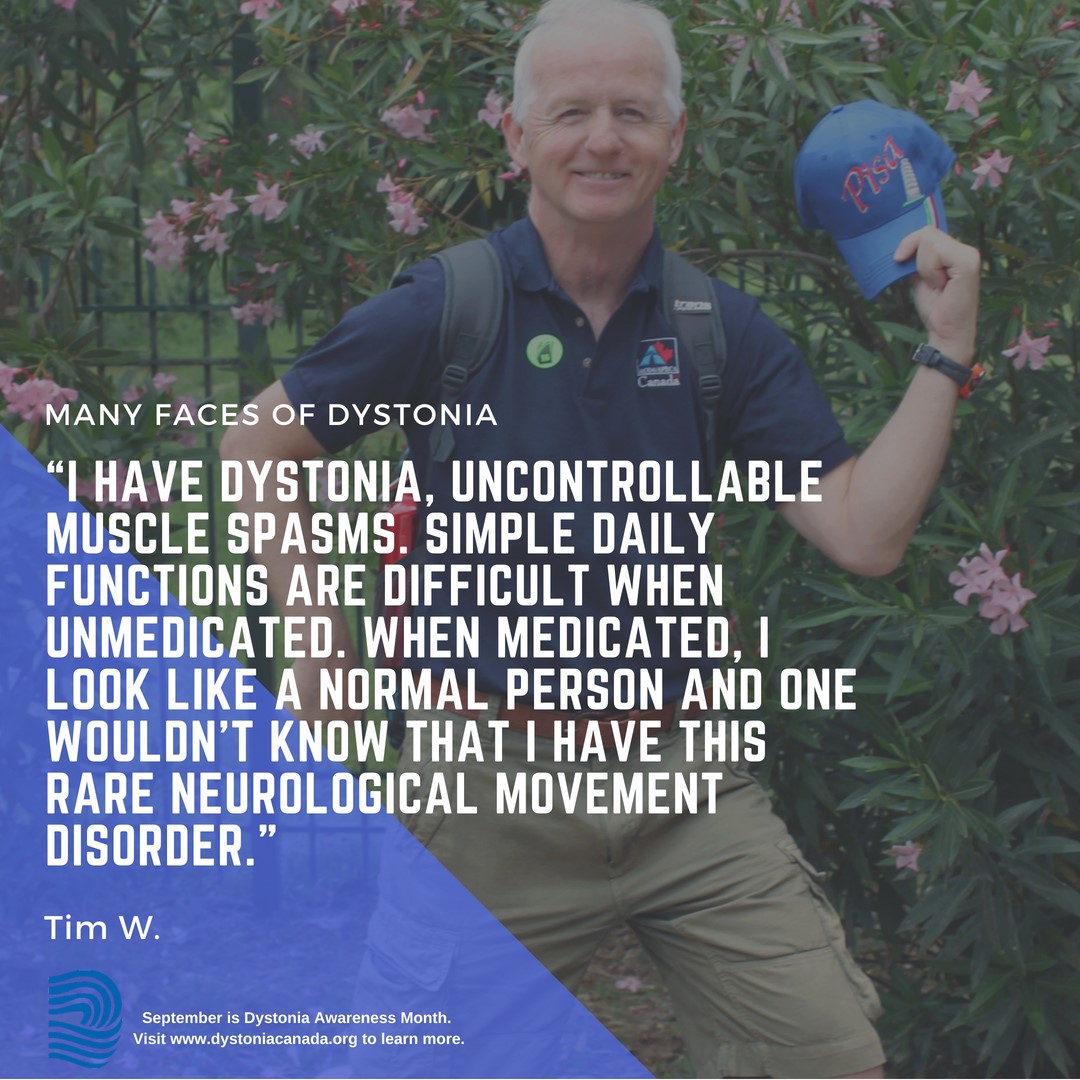 Tim Williston lives in New Brunswick with his wife, Nancy. He is a traveller and a sports enthusiast, who loves a good action movie (although he’ll concede the occasional compromise and watch a rom-com). He is a self-described positive person, and the effects of his positivity are apparent in his close relationships with family and friends. Tim has also been living with dystonia for the last 17 years and has weathered many of the challenges and permanent changes this has brought with it. Tim has worked and continues to work very hard at keeping his positivity shining through, while he acknowledges many of the challenges he faces internally.
Tim Williston lives in New Brunswick with his wife, Nancy. He is a traveller and a sports enthusiast, who loves a good action movie (although he’ll concede the occasional compromise and watch a rom-com). He is a self-described positive person, and the effects of his positivity are apparent in his close relationships with family and friends. Tim has also been living with dystonia for the last 17 years and has weathered many of the challenges and permanent changes this has brought with it. Tim has worked and continues to work very hard at keeping his positivity shining through, while he acknowledges many of the challenges he faces internally. We had the chance to find out how dystonia has changed Tim’s life, how he manages to continue doing what he enjoys and how his family and friends support him. Tim shared his story in hopes that it will let others with dystonia know they are not alone and can help their loved ones further understand what it is like to live with this disorder.
Tim was diagnosed with torticollis and blepharospasm in 2004. His symptoms were severe and very apparent. “My head would move back and to the side very violently. It was apparent if you were in the room with me,” he describes. Following unsuccessful treatments, he underwent Deep Brain Stimulation (DBS) surgery in 2006 and after a couple of years of programming, found settings that were optimized for him. During that time, Tim became involved in DMRF Canada, first as a local contact, then a support group leader and finally a board member (from 2018-2020). The effectiveness of the DBS began to wane and in 2018, Tim underwent a second DBS. He has gone through a long process with the help of his family, friends and medical team to begin the road to “getting back into the groove” and prioritizing the things that are important to him.
To read more about Tim’s journey with dystonia, please visit: https://dystoniacanada.org/TimWilliston
- John Fraser: Chuck's Run Fundraiser and Dystonia Advocate
A Reflection on the Power of Fundraising and Community
 When I decided to participate in DMRF Canada’s 2018 Chuck’s Run, Walk, and Wheel for Dystonia, it was the first time I actively committed to fundraising for treatment and awareness about the disorder. I’ve lived with Cervical Dystonia for 13 years and have been able to manage easily by receiving neurotoxin treatments on a regular basis. Over time I’ve learned a lot about dystonia, its many forms and treatments, and the challenges it creates for thousands of people who live at war with their own bodies every day. I’ve developed a sense of ownership and responsibility for sharing my experience and teaching others about dystonia.
When I decided to participate in DMRF Canada’s 2018 Chuck’s Run, Walk, and Wheel for Dystonia, it was the first time I actively committed to fundraising for treatment and awareness about the disorder. I’ve lived with Cervical Dystonia for 13 years and have been able to manage easily by receiving neurotoxin treatments on a regular basis. Over time I’ve learned a lot about dystonia, its many forms and treatments, and the challenges it creates for thousands of people who live at war with their own bodies every day. I’ve developed a sense of ownership and responsibility for sharing my experience and teaching others about dystonia.For me, Chuck’s Run was a culmination of these feelings. Moreover, I experienced community and a sense of personal pride that I expect will never leave me. I also learned some important lessons along the way. After setting up my fundraising page online with a heartfelt plea and a reasonable goal to raise $1000 over two months, I shared my link with the social media gods and sat back to let the donations come rolling in. And they did. My parents got things started with a remarkably generous gift, followed by a stream of family friends whom I hadn’t spoken to in ages. My closest friends were of course on board, and I had quickly raised over $400. Then response dried up a bit. I tried re-posting my link, “liking” my own posts, and sending group messages to all of my mobile contacts. No luck. Don’t get me wrong, I wasn’t unhappy. Any amount that I could raise was great, but with the race two weeks away, I resigned myself to the fact that I wouldn’t meet my goal.
With one week to go before heading to Toronto, I decided to make a last push to raise more money for the DMRF. Laptop in hand, I began to send personal emails to each of my social media friends. Nothing fancy, simply an update on my progress and the link to my fundraising page. As I was writing, I received a new mail notification. “You’ve received a donation!” Then another. And another. Five, then six, then eight new donations. Within two hours I was at a total of $920 raised. My friend Geordie, who had committed to supporting me from the moment I told him about Chuck’s Run, still hadn’t visited my page. I didn’t want to bother him again, but I was so close! Finally, I broke down and sent him an email that said, simply, “If you still want to help me, time is almost up.”
That evening, I opened my last “You’ve received a donation!” email. It was a pledge for $81 from Geordie with a brief message. “There. You did it.” During my whole experience with Chuck’s Run, that moment was the most emotional. All of the support from friends and family came home to me in that instant, punctuated by Geordie’s final act of kindness. I was completely overwhelmed.
On the morning of June 3rd, I reported to High Park in Toronto with my family in tow. I decided to walk the course so that we could participate together, my dad to my youngest niece (I was also in far worse shape than I had hoped to be). The weather held, the park was beautiful, and we walked as a group. Along the way I took time with each member of my family, to catch up on their own lives and thank them for standing with me. I marvelled at the large number of young volunteers who lined the route, shouting encouragement and guiding the way. I imagined that few if any of the volunteers were dystonia patients; they were more, a group of people brought together in community to support our cause with enthusiasm and joy. When we crossed the finish line, I felt truly victorious.
My experience with Chuck’s Run has been uplifting, and rewarding, and has erased the version of myself who viewed dystonia as a solitary burden that only I could understand.
I mentioned some lessons, so here they are: In fundraising, perseverance is important. It’s not enough to assume that people will automatically get involved. Many folks absolutely wanted to support me through Chuck’s Run, but the business of living always draws on time, and resources, and attention. To remind others of your work isn’t begging or pestering; it’s commitment, and many of my friends appreciated the chance to help. And for those who couldn’t donate, I’d wager that not a single one begrudged my asking. Most importantly, I’ve learned that events like Chuck’s Run aren’t about lamenting over challenges, or comparing battle scars, or wishing that life were somehow different. They are about family, and community, and celebration. I’m already looking forward to next year’s run; if you choose to get involved, I wish you the best, I thank you, and I hope to see you in High Park next year.
John Fraser, Chuck's Run Fundraiser and Dystonia Advocate
- Astrid Frauscher: Parent and Inspiration
 It’s critical for single parents with medical disabilities to “stay positive” for the sake of their children, said Calgarian, Astrid Frauscher, 44, cervical dystonia patient.
It’s critical for single parents with medical disabilities to “stay positive” for the sake of their children, said Calgarian, Astrid Frauscher, 44, cervical dystonia patient.Although she was born in Sudbury Ont., Frauscher moved to Calgary at just eight years old and has lived there ever since. It wasn’t until 2011, however, when her health started to deteriorate.
She quickly became familiar with the many difficulties that her condition would bring. Frauscher’s neck, paralyzed on a right angle, left her no choice but to struggle with chronic pain everyday. “I wasn’t actually diagnosed with cervical dystonia until 2014. I worked for almost three years in severe pain just trying to ignore how bad it actually was. “I find myself going into dark places often,” explained Frauscher.
“But, for my children, I keep myself going, I have no choice.”
The three children, Ryan Russell, Anika Russell and Kurtis Frauscher, are the most important members of her support system and aid her in many ways on a day-to-day basis. Without them, she fears that her greatest insecurities would become her.
Anika Russell, Frauscher’s only daughter, admires her mother’s perseverance and positivity more than she can truly express. “She is an astounding woman for being able to cope with a chronic illness and still remain so positive for the future,” said Russell. “I want her to know that I understand how challenging this is for her and that she has my unwavering support and admiration.”
Russell explained that the fact that her mother continues to raise her five-year-old brother, Kurtis, while also going through this hardship, makes her “beyond proud.”
Clive Mountford, a previous co-worker and friend of Frauschers’, said that she has had nothing but a positive impact on his life, as well as his daughter’s.
“Astrid is an absolute inspiration. I am a single parent myself. Even though I do not have a rare medical condition, I am not half the parent that Astrid is.
“Her willingness to move forward with everything that is constantly being thrown her way is just amazing,” raved Mountford. “It’s incredible what some people can go through and put up with when their only real concern is their children’s well being.”
Mountford’s friendship with Frauscher has grown throughout the years, and he intends to see her recovery through until she is completely free of her condition.
One of Frauscher’s best friends, Heather Fjeld, said a most moving aspect of her friends’ life is that although her illness is not well known, Frauscher continues to “keep her head up” while also attempting to spread awareness for her condition.
“Cervical dystonia is idiopathic, which means that there is currently no known cause for the condition.
“All that Astrid can do for her condition at this point is, medication, Botox, and deep brain stimulation surgery (or DVS). While these methods may work, they are only temporary fixes to Astrid’s problems,” said Fjeld.
Fjeld explained that although chronic pain was a major side effect of Frauscher’s condition, the overall stress that her illness had caused her become so intense that she often fell physically ill.
Fjeld also said that despite watching her friend go through the unimaginable, she has learned nothing but patience, kindness and the meaning of true friendship from her. However, five-year-old son Kurtis Frauscher is perhaps his mother’s biggest fan. He thinks that his mother deserves the title of that of a superhero. “She’s with me every day and she brings me everywhere,” said Kurtis Frauscher. “I love her 10 million times more than anyone, ever.”
Originally printed by: Kylee Williams, Group B
- Laurie Bell: Going the Extra Mile
Hamilton Support Group Leader Laurie Bell steps down as the Leader of the Hamilton Support Group. Here is Laurie’s story.
 I was diagnosed in 1989. At that time, I was 36 years old, working full time with two sons (ages eleven and nine). I had a great job that was physically taxing but making better money than I had ever expected to. I was not a college graduate. I made good wages, had benefits and a pension plan…good stuff for a working Mom.
I was diagnosed in 1989. At that time, I was 36 years old, working full time with two sons (ages eleven and nine). I had a great job that was physically taxing but making better money than I had ever expected to. I was not a college graduate. I made good wages, had benefits and a pension plan…good stuff for a working Mom.I had ear aches, jaw aches, head aches. I had been seeing a chiropractor, but he could do nothing about the neck pain. I always carried Extra Strength Tylenol in my purse. I went to specialists and pestered my dentist, but to no avail.
I was at a wedding in September of that year, and I was keeping an ice pack on my neck by this time. My sister, who was a Maid of Honour at the wedding, advised me to see her neurologist. My sister had been living with generalized dystonia since she was 5 years old. Fortunately, she knew the symptoms.
So, I went to the neurologist, who, after a quick physical exam in her office, diagnosed me with Cervical Dystonia. I took the medication she prescribed and she said I’d be back to work in six weeks. Six week later I was in a wheel chair, so I stopped taking the pills and went to a different neurologist. By this time, I was grappling with debilitating migraines and a neck that was frozen in place. I could not drive.
At the time, there was a fledgling Dystonia Foundation that was heavy on the workload and very light on information. We had no way of connecting with others, no way to learn more about the ways my life would change. I only had my sister and her experience to draw on.
In 1993 I had surgery in Montreal, called selective denervation. Selective denervation surgery involves severing the nerve that carries the incorrect messages between the affected muscle and the brain. It did not straighten my neck, but released my right sternocleidomastoid muscle (SCM) from its spasm, thus loosing all neck support on the right side. I did gain flexion and have had no migraines since this procedure.
The change in my neck posture caused my body to bend extremely, to compensate for the crooked world my eyes saw, and after years of walking /standing bent to the left, I developed a severe scoliosis (abnormal curvature of the spine). I began a physiotherapy regimen in 2006.
Anyone can manifest dystonic symptoms, any race, any age or gender. The condition does not discriminate. My Neurologist now diagnoses me as having segmental dystonia, as my facial spasms and hand tremor are involved. There are several treatments available. Sadly, none of these treatments are cures.
I personally use a few pharmaceuticals – but nothing with codeine since I began my physiotherapy routine. My pain levels are much lower, and my body strength has vastly improved. My mobility continues a downhill slide, for which we have no practical answer. It could be postural; it is NOT dystonic. It is a severe and constant worry. I use a lot of yoga. I modify my postures and thankfully my instructor is good with that.
My physiotherapy routine includes resistance training, balance work, weight lifting, and core strengthening. Hamstring stretches, hip flexor stretches, some manual neck stretches and massage are also part of my routine.
Stress and fatigue are definite factors in the symptoms gaining severity. This is one thing that all dystonia patients I have met have in common. That, and a dream of a cure.
-Laurie Bell
- Cheryl Dillon: If I Were a Supermodel
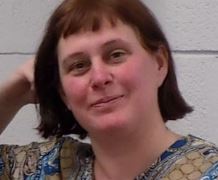 If I were a Supermodel, I probably would welcome the stares. I receive a lot of attention from people trying to understand what they’re looking at. “Are you on the phone?” “Are you having a seizure?” “Are you really going to drive?” While the public’s trying to understand what they’re seeing, I’m trying to live inconspicuously.
If I were a Supermodel, I probably would welcome the stares. I receive a lot of attention from people trying to understand what they’re looking at. “Are you on the phone?” “Are you having a seizure?” “Are you really going to drive?” While the public’s trying to understand what they’re seeing, I’m trying to live inconspicuously. I was diagnosed with Cervical Dystonia, a movement disorder that causes involuntary contractions and spasms of the muscles in the head and neck. In this disorder, the normal mechanism of the brain that makes muscles relax is not functioning properly. The involuntary muscle contractions that occur often force the body into repetitive and twisting movements that cause irregular postures and pain. Sometimes, I experience a neurological ‘storm’ where my entire body shakes uncontrollably, like a Parkinson’s patient. These storms can happen anywhere and at any time, lasting 15 to 30 minutes, and are exhausting.
I heard that anguish prepares us to teach others. I don’t always want to be ‘the teacher’. I don’t want to be ‘the student’. Heck, given the choice, I would love to ‘drop’ this ‘course’ altogether! As I prepare to take my dogs out for their walk, we each get a collar. We, all three of us, would love to run away, yet our circumstances (the collar) hold us in place.
Having this condition has forced me to look at how I do things. In considering employment, there are many positions I wouldn’t be well suited for. I know I’ll never be a pole racer, pole vaulter, or even a pole dancer; something about being upside down, loss of balance…Driving instructor, Customs Officer, even fry cook, although I did try to be a fry-cook.
My neck movement usually stops when my head is at rest, fully supported. Great! Can you think of any jobs I can do lying down? Mechanic maybe? Astronaut? Not likely. With this diagnosis, I’ve had to reflect on my skills and gifts to find a purpose. What is my purpose? Without purpose, a life has no meaning. Conversely, when a life has no meaning, there is no purpose for living. Yes, I had some very dark thoughts, but I knew that there was something out there for me. A reason I developed this disorder. I just had to find it.
I continue to search for an answer. Anyone who knows me knows that I live life gregariously and do not shy away from being in the spotlight. I belong to a public speaking club and regularly provide speeches and education sessions. I chair various church committees. I organized fundraising for our local Dystonia group. I train twice a week with a personal trainer. I’m not ready to give up the fight to move freely and on my terms. My wish is for a cure and for compassion. If you see me, please, Stop Staring! It’s not like I have two heads, just one moving really fast. Maybe I am a (super) model after all.
- Jennifer Ashton: Author, Artist, Educator
Jackson Mooney Patient Grant Winner 2020 – Meet Jennifer Ashton
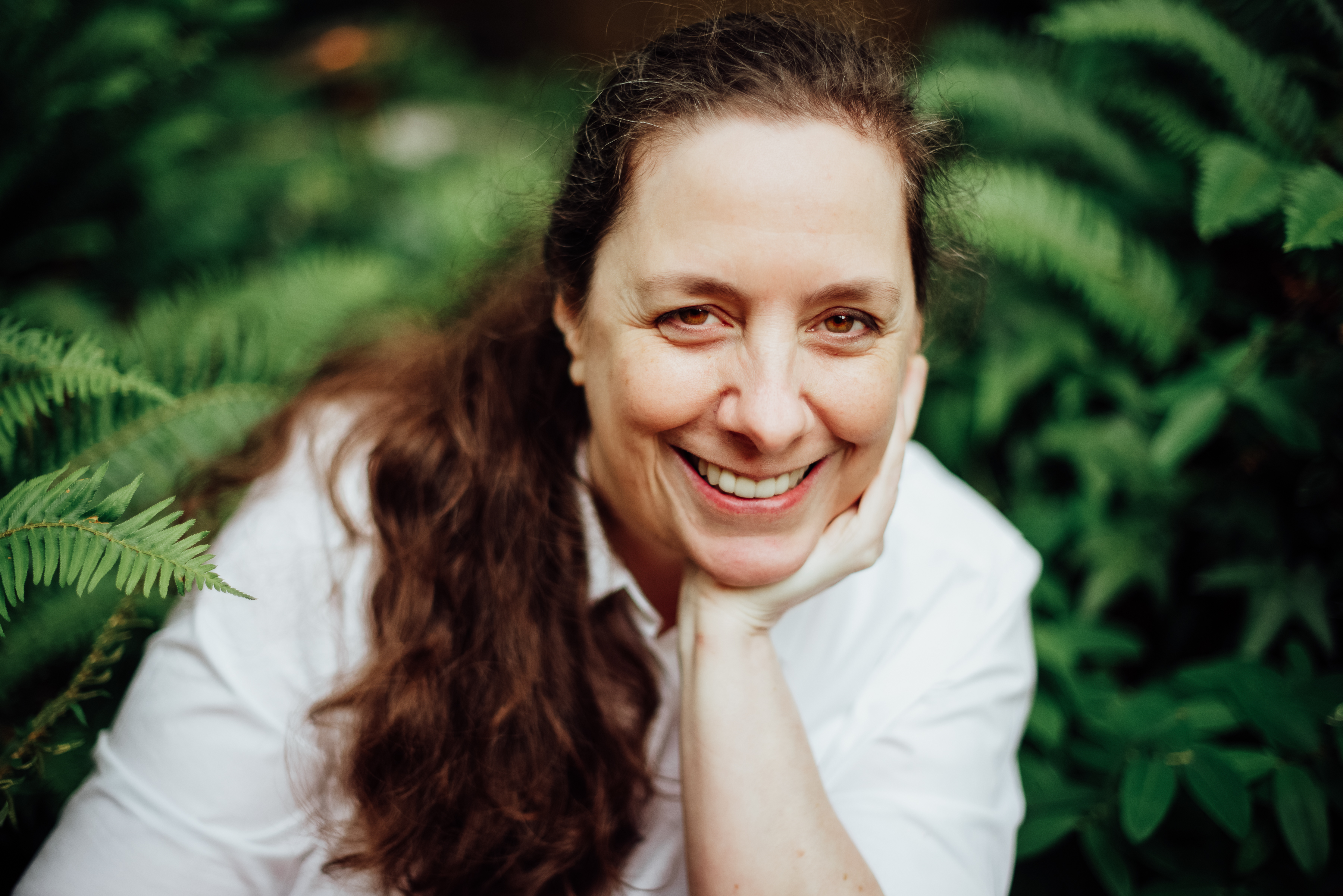 Jennifer (Jenn) Ashton, an award-winning author and visual artist living in North Vancouver, B.C., was diagnosed with Cervical Dystonia in February 2020 after nearly 20 years of being misdiagnosed with Multiple sclerosis (MS). Despite the challenges of her condition, Jenn remains committed to lifelong learning. Her goal was to pursue a Certificate in Advanced Education Leadership with the long-term goal of teaching and/or writing policy and procedure at the administrative level for First Nations programming, which is a particular passion, given that Jenn is of Squamish First Nations Ancestry.
Jennifer (Jenn) Ashton, an award-winning author and visual artist living in North Vancouver, B.C., was diagnosed with Cervical Dystonia in February 2020 after nearly 20 years of being misdiagnosed with Multiple sclerosis (MS). Despite the challenges of her condition, Jenn remains committed to lifelong learning. Her goal was to pursue a Certificate in Advanced Education Leadership with the long-term goal of teaching and/or writing policy and procedure at the administrative level for First Nations programming, which is a particular passion, given that Jenn is of Squamish First Nations Ancestry.Her passion for education and her journey with dystonia have inspired many. In 2020, Jenn was one of the Jackson Mooney Patient (JMP) Grant winners, which helped her successfully complete the Higher Education Teaching Certificate at Harvard. Since then, Jenn has continued to excel in her creative pursuits and has been published 29 times and has received the following writing accolades:
- Honourable Mention, Subterrain Magazine, Lush
- Triumphant Literary Award for Nonfiction (2022) For “Qualifying Hymns”
- Longlist: Susan Crean Award for Nonfiction(2022) For “100 Better Days”
- Shortlist: Indigenous Voices Award for Unpublished Prose in English (2022) For “Hail Mary, Mother of Pearl”
- 1st Place - Doula Support Foundation’s Birth Story Contest (2021)
Jenn was also accepted into a national screenwriting program and she has just received word that one of her short films was selected for the Vancouver Island Short Film Festival! Beyond her creative pursuits, Jenn has successfully received a number of other scholarships, and awards, including a scholarship to study at the University of Oxford. Most recently, she was accepted into the University of Edinburgh to begin her MSc in History this coming fall.
At times over the past few years, Jenn’s dystonia has been challenging. “Higher stress levels, workloads and little time for regular exercise have set me down some painful roads, but it is also a great reminder that I must take care of myself first.” Despite challenges with her dystonia, Jenn has remained positive and focused on finding balance in all aspects of her life. She is grateful for the support of DMRF Canada and has even taken on a volunteer role with the organization. Through her perseverance and creativity, Jenn continues to inspire others living with dystonia.
To learn more about Jenn and her book, which aims to raise awareness of dystonia, visit her website at www.jenniferashton.ca.
A friendly reminder that we all need to remember to take care of ourselves first! Please refer to www.dystoniacanada.org/living-with-dystonia for a collection of tips and tools.
- Sumbul Zafar: Leader and Champion
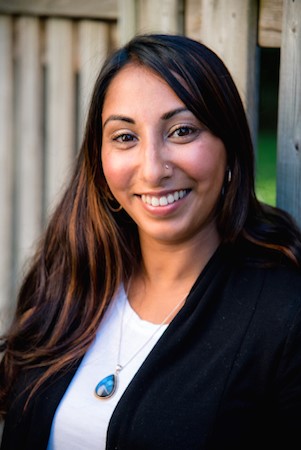 The dystonia community is filled with leaders and champions, one of them being Sumbul Zafar. Sumbul is a wife, a mother to three wonderful children, a business owner, a dystonia advocate, a competitive Para swimmer, and our 2024 Freedom to Move Ambassador. Sumbul has launched her own campaign to raise awareness and funds for dystonia as she swims her way to the 2023 Fina World Masters Championship in Japan.
The dystonia community is filled with leaders and champions, one of them being Sumbul Zafar. Sumbul is a wife, a mother to three wonderful children, a business owner, a dystonia advocate, a competitive Para swimmer, and our 2024 Freedom to Move Ambassador. Sumbul has launched her own campaign to raise awareness and funds for dystonia as she swims her way to the 2023 Fina World Masters Championship in Japan.Sumbul’s journey with swimming can be described as “full circle”. Her passion for swimming was ignited in early childhood with her first lesson taking place at age three and joining a competitive swim team at ten.
Shortly after qualifying for the 2014 Fina World Masters in Montréal, Sumbul suffered a stroke, which left residual impacts to the right side of her body. The involuntary muscle spasms and twisting of her body prevented Sumbul from attending the championships and eventually, she was diagnosed with dystonia.
Despite her diagnosis, Sumbul was determined to continue swimming. However, Sumbul was frustrated that she wasn’t swimming at the caliber that she had been prior to her stroke, and her confidence was shaken. She attempted to rejoin competitive swimming from 2015 to 2017 but fell short of completing those seasons due to a lack of understanding how to train with dystonia. It took another child and the pandemic to give Sumbul the time to look inward. She recognized that she had disengaged from the activities she loved and kept her world small to live a less challenging life. She also realized that she was not truly living her life to the fullest.
Returning to swimming with a renewed sense of clarity, Sumbul eagerly trained for the opportunity to compete in the 2023 Fina World Masters in Japan and upon registering for the season discovered the dystonia was an eligible physical impairment to be classified as a Para swimmer. Over the last year, Sumbul has had the opportunity to travel to the USA and France representing Canada on theWorld Para Swimming Series. Sumbul looks forward to continuing her training towards her goal of making a World Championship team and looks forward to continuing to represent Canada as a Para Swimmer in the years to come.
When asked how Sumbul balances pursuing her dream of competitive swimming, life with dystonia and her family responsibilities, she credits the power of her support network which includes her three children and her husband, Ryan. “It’s important to engage your support network when living with dystonia, as one diagnosis can change so many people’s lives. We work together as a team to achieve our goals while respecting each other’s boundaries and time” shares Sumbul.
To read more about Sumbul’s journey with dystonia, please visit: https://dystoniacanada.org/sumbulzafar
To follow Sumbul along her journey, checkout her Instagram Page.
Click here to view Sumbul's Campaign on Canada Helps.
- Lise Filion: Never Give Up
My name is Lise Filion and I live with a chronic disorder named Cervical Dystonia also called Spasmodic Torticollis.

I was diagnosed with this incurable condition after a vehicle accident where I was hit by a vehicle on my front passenger side. My head flew to the right, and I could not move it to the middle for many years.
After the accident I could barely walk for more than 5 minutes. I could not hold my head straight. I needed a lot of therapy (physiotherapy, heat therapy, chiropractic therapy, pool exercises and manual osteopathy).
After receiving Botulinum injections (Botox) every 3 months in the neck, shoulders, and cranium, I went into remission in 2014, three years after I started receiving therapy. The Botox really helped me regain balance. The only thing that remains is a pulling and pushing (like a rubber band) feeling in the shoulders and neck.
There is a quality of life with Dystonia. It requires a lot of fortitude, patience, willingness to succeed and alternative remedies to help the body be at peace.
I can swim lengths in a pool twice a week, walk at a slow pace, stretch and do yoga, cook nutritious meals, and clean my home at a slow pace. I have friends that support me and understand my limitations and accept them.
I am committed to my artwork, and I live a life of peacefulness free of worries and expectations. Each moment is a blessing, and I am grateful for the life that I have created for myself.
My motto is Never Give Up. There is always hope and you are stronger than you think, more courageous than you can imagine and loved more than you know.
- Ken Jenkins: I'll Work Through It
Ken Jenkins, a lifelong resident of Guelph, Ontario, loves hiking and biking outdoors, and plays in a beach volleyball league with his wife Ruth. But his active and social lifestyle came to a grinding halt when contractions in his neck muscles froze his neck and head in place at an odd upward angle. He appeared to be looking up and over his left shoulder. And he couldn’t move his head from the awkward position.

“My head was stuck in this position and the pain was incredible. Every single day, all day long, the pain was awful,” he says. “The way I describe it to people is if you turn your head as far as you can to the left, like you’re trying to look over your left shoulder as far as you can and then turn it a little bit more and look toward the ceiling. I had no control over it.”
The worst part was the fear of not knowing what was wrong or if anything could be done.
Ken, 60, eventually was diagnosed with cervical dystonia, a rare neurological disorder that affects the neck and shoulder muscles, turning the head to the side or forcing the head back or forward, according to Dystonia Medical Research Foundation Canada. It’s one of the many types of dystonia movement disorders that cause excessive, involuntary muscle contractions. These muscle contractions result in abnormal and painful muscle movements, spasms and body postures, making it difficult for people to control their movements or carry out daily activities. Dystonic movements are typically patterned and repetitive.
"So there’s nothing physically wrong. It’s like an overactive brain. The brain is sending the signals to these muscles, telling them to contract,” he says of how he explains the condition to others.
“I was very fortunate once I was pretty sure it was cervical dystonia. There is no cure for it, but I knew that this is not going to kill me, so I’m still going to be OK. I’ll work through it.”
Credit to Healthing.ca. To read more about Ken's story, please visit: What it feels like: Finding the silver lining in the uncertainties and spasms of cervical dystonia
Thank you to Healthing.ca and Karen Hawthorne for writing this article and allowing us to share it.
Muscle groups affected: face, neck, shoulder, torso, and/or limbs
- Alicia McGill: Awareness Ambassador and Fundraising Hero
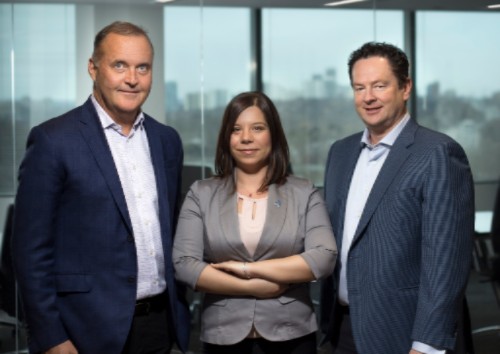
Alicia (center) with her bosses, Stephen Massel (left) Gerry Martin (right)
Alicia was diagnosed with dystonia back in 2015, and instead of letting her diagnosis stop her she rose up and engaged her entire workplace, family and friends, educating and promoting awareness about dystonia in her community. She was the single most successful fundraiser in Chuck’s Run history. Read our original article with Alicia’s story here.
Now, a year later, we’re thrilled to be working with Alicia again to raise awareness and support for dystonia in Canada. Here’s what she has to say about what she’s learned, why dystonia awareness is so important, and how she plans to move forward.
DMRF Canada: What has your dystonia diagnosis taught you?
AM: My diagnosis has taught me a lot about who I am as a person. I am not a dystonia sufferer nor am I a dystonia survivor. Having dystonia and learning how to manage it forced me to re-evaluate how I live my life and what I want to achieve. I still have goals and dreams that I refuse to give up on and I think that's important. A healthy positive mindset is what keeps me going. I have adopted a healthy lifestyle in which I changed my eating habits, ensure I get enough rest, exercise, regular checkups at the doctor, and keep my overall nutrition in check. But above all, I have learned to be more compassionate and understanding towards myself about what I am able to do each day instead of berating myself for the things that I struggle with. I had to let go of what the rest of the world considers a 'normal' life and start working with where I am because there certainly are physical and emotional aspects that I have to respect in order to move forward. Finally, I have learned how to let others in and share my experience. Feeling alone and isolated was something I had felt for a very long time. But my friends, work colleagues and especially my family have shown that they are always there to support me, so it is important that I let go of pride and ask for help when I need it.
DMRF Canada: What is the most difficult thing about having dystonia?
AM: That is a loaded question! It is hard to pinpoint what the most difficult part of having dystonia is because from my perspective, everything can be challenging. The physical and emotional impact of having dystonia is extremely difficult. There are days when I'm in a really bad episode where all I can do is lay in bed and twitch. When that happens, I am essentially paralyzed; I cannot speak properly, I cannot process my thoughts or act on them, and I'm usually in a significant amount of pain. I have certainly had times where I wondered if I would ever walk again. But aside from the physical challenges, I think the emotional side is actually more difficult to cope with. I have wondered if I can maintain the busy, demanding, and often stressful accounting job that I have. I live alone and sometimes it is really hard to find the energy and strength to cook, clean, and go run errands like grocery shopping. The very simple things in life can be a significant challenge and for me, that is the part that has been extremely frustrating. Doctors and health advisers tell you what you need to do to keep dystonia and your life balanced, but when you don't even have the energy to buy your own groceries, how are you supposed to keep that balanced lifestyle? Sadly, I feel a little let down by the medical community regarding dystonia. I can’t help thinking some of my suffering could have been avoided if medical practitioners had a better understanding of the affliction. I often felt extremely alienated by the medical community. There are many times I have thought that I can't live my life like this and have wanted to give up. But when I have those days, I turn to my wonderful support systems as mentioned above, who help me through it. I think I will probably always have those days, but I can certainly lead my life in such a way that I am no longer in denial about my situation and assist myself in whatever way I can to persevere.
DMRF Canada: Why is raising awareness of dystonia so important?
AM: Awareness is important to me because there is a large disconnect within the medical community about how to diagnose and treat people with dystonia. After I was diagnosed, I was sent to a mental hospital for an evaluation. It occurred to me that the doctors who were working with me still consider functional dystonia as a form of malingering. Nevertheless, I obliged and went for the evaluation. I asked the psychologist why some doctors in the medical community associate dystonia with a mental disorder simply because emotions (stress), often exacerbate the movements. Everyone internalizes trauma and stress differently and just because nothing has been found in my blood work does not mean I do not have a neurological problem. One of the things that has never made sense to me is my diagnosis with functional dystonia. My family has a long history of neurological disease and disorders so I don't think it is a coincidence that I have dystonia. But unfortunately, the research is not there to identify what the true cause is. Government bodies and the general public don't know what dystonia is either. I've had difficulty getting accessible parking permits when I could barely walk and we do not have proper government funding available to dystonia patients because of the lack of awareness. The medical community, government bodies, and Canadians need to know about dystonia. We need more funding for research we desperately need so that people like me can have a better quality of life.
DMRF Canada: Why are you choosing to participate in Chuck’s Run and choosing to support the DMRF Canada?
AM: I support the DMRF Canada because when I had no one else to turn to, they were there to provide support and guidance. That assistance made such a difference when I was struggling with my diagnosis. Canadians need to help the DMRF to raise awareness and funds for research and so I recognize how important it is to help the DMRF Canada in any way I can. I only started participating in Chuck's Run in 2016 because before that, I didn't even know it existed. But I will continue to participate every single year. Going to Chuck's Run last year and this year is a way for me personally to acknowledge my situation. I spent a long time in a place of denial about having dystonia and so Chuck's Run is a way for me to confront and walk (or run), through that fear (no pun intended)! But I also go to Chuck's Run to support others. Really supporting the DMRF Canada and going to Chuck's Run is not about me personally. It is about all of us. I have learned how important allowing others to support you is and it has been very important for me to talk about my situation with others because it helps me get comfortable with who I am. I think Chuck's Run is a great way to generate more exposure for the DMRF Canada, for dystonia, to generate funds we need for research, and for each and every one of us that have dystonia to get together and support and even inspire each other. For those who participate that do not have dystonia, well they're doing the exact same thing as the folks that do have dystonia - supporting and inspiring. From my perspective, we really are one big family! Chuck's Run is sort of like the annual family reunion, which is equally important as generating awareness and funding for research.
DMRF Canada: Is there anything else you would like to add?
AM: I would like to take this opportunity to appeal to employers. Please know that your ongoing support can and will make a significant impact on the quality of life of those employees with dystonia. My bosses, the CEO and CFO, have played a pivotal role in helping me recover over the last year. Without the leadership, kindness, compassion, and support of my employer, I may very well still be in a wheelchair. I feel a deep sense of gratitude and love towards both of my bosses for how they have handled my situation and I am very lucky to have them. Their part in my recovery has enabled me to move forward with my career goals, given me a better quality of life, and has helped me feel like I have a chance at a fairly normal future. I have a flexible work schedule in that if I am feeling unwell and unable to control the movements, I have the green light to go home. When I was having trouble walking, they set me up so I could do work from home. I have had modified workloads and both my bosses have personally offered to share the workload when I have needed it. They can see I love my job and that I try to do my best every day. I work very hard, but they understand that having dystonia has been difficult for me physically and emotionally and they have both been there to talk to me when I am having a rough day or week. Many people say that what the CEO at my company has done is not normal and that not many companies would do what he has done. However, he believes that is selling most employers short. According to Martin, “the issue is far too often, employers do not even know their employee has dystonia, and if they do know, they don’t truly understand what that means. The key is awareness and flexibility”. I was fortunate that my bosses realized I still wanted to contribute and they made it possible for me to do so. My hope is the treatment I received from my employer can indeed be the norm in Canada. As a person with dystonia, my own determination and ambition to do well at work is even more important to me because I am treated well. Proudly, I am not draining company profits; instead I am still helping to generate them.
Blepharospasm / Meige Syndrome
Muscle groups affected: eyelids
- Colin: The Power of Positive Thinking
 In 1980 at age 39 I began having neck pain, pulling to the left twisting my body and my eyelids were closing. After seeing over 11 specialists of varying degrees I was lucky enough to have an appointment with Neurologist Dr. Donald Calne who had recently opened the Neurological Department of the newly built U.B.C. Hospital.
In 1980 at age 39 I began having neck pain, pulling to the left twisting my body and my eyelids were closing. After seeing over 11 specialists of varying degrees I was lucky enough to have an appointment with Neurologist Dr. Donald Calne who had recently opened the Neurological Department of the newly built U.B.C. Hospital.I was diagnosed with Meige Syndrome; a combination of blepharospasm of the eyes and torticollis of the neck. He explained everything to me known about the disease and the fact that there was no known cure. I spent the better part of a year under his care in and out of the hospital trying a variety of treatments and medications. My condition was rapidly deteriorating moving through my body. The only thing helping me was high doses of Ativan daily and it only helped ease the pain, relaxing me and making me feel more comfortable.
I tried neurotoxin injections for my blepharospasm and after a few tries we had good results! I was now able to drive my car again which was a blessing in itself. I was treated by an eye specialist who was a leader in the use of neurotoxin injections. My eyes were doing so well we discussed the possibility of trying neurotoxin for my cervical dystonia. They agreed to do the procedure at the UBC. hospital with myself and two other patients who also had torticollis of the neck. My procedure was not successful but the other two were showing improvement. That was the first procedure in the world using Botox for torticollus of the neck.
I next got appointments to see two other Doctors - one in particular - a Professor Marsden who specialized in Dystonia- gave me hope. He said that he had known of a patient whose symptoms had gotten better and was now in remission. He said "one day you may wake up and find things are improving."
With that news I felt there was hope and about a year later I started to notice some slight improvement in my symptoms Time passed and very slowly my symptoms improved so much that to an untrained eye I looked normal.
My Doctor said he had not seen this kind of improvement as my dystonia was one of the worst he had seen. He asked me what I thought about going back to work, of course I was overjoyed. He said it appeared I was in full remission. I went back to Real Estate and was enjoying working again.
After a period of about six months I started having trouble with my speech around three in the afternoon I was experiencing difficulty with my pronunciation of some words. Dr. Calne said unfortunately my Dystonia had returned as Spasmodic Dysphonia and I should l stop work immediately to avoid any more stress. This problem started to improve although very slowly to where I am now with virtually no visible symptoms and my speech is normal. This whole Spasmodic Dysphonia episode lasted a total of about ten years.
On a regular follow up visit to Dr. Calne I told him my handwriting was getting quite bad and that I was having trouble even signing my name, after several tests he said it was unfortunately another form of Dystonia working its way through my body and called it " Classic writer's cramp."
All In all I feel very fortunate having gone through all of that and still be able to enjoy life even if it is a little compromised. With the help of the computer keyboard I can now type so writing isn't so necessary.
I have written this to possibly give hope to some of those suffering from this dreadful debilitating neurological disorder. Don't give up and never stop looking for answers. The power of positive thinking is amazing as to what it can do and lead too.
Muscle groups affected: neck, torso, arms
- Casey Kidson-Reid: 'Dyfying' Dystonia
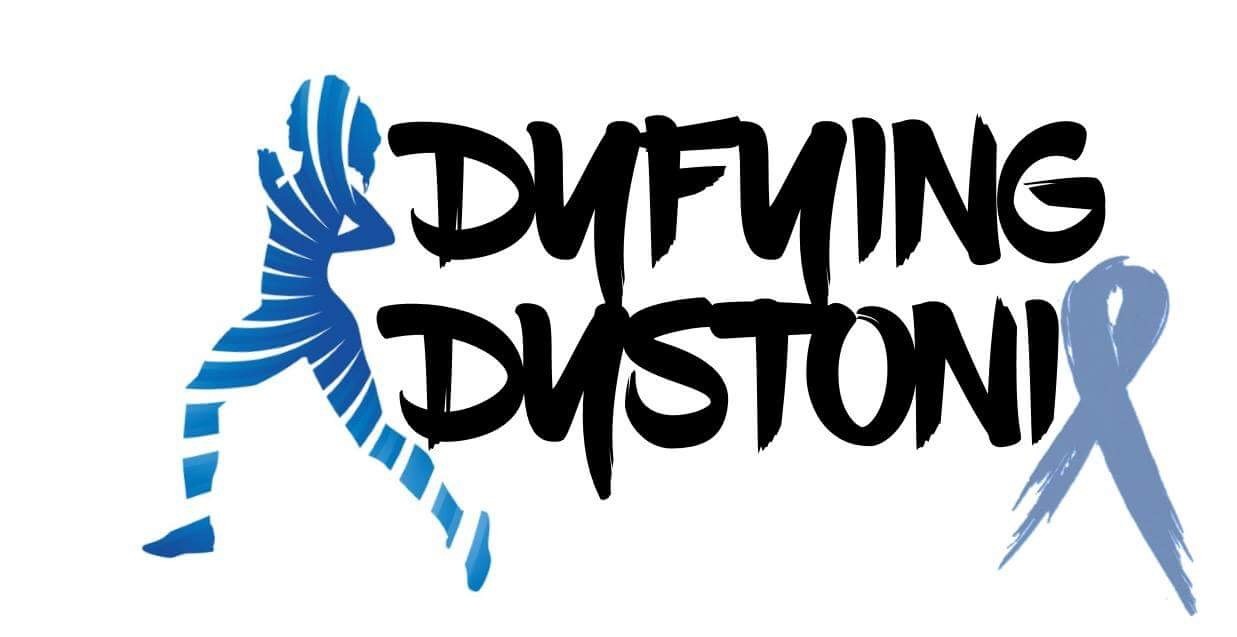
“Running on behalf of DMRF Canada has allowed me to ignite my inner passion and strength. It has allowed me to build a stronger connection with the Dystonia community, raise awareness and offer support and hope for those also diagnosed with dystonia."
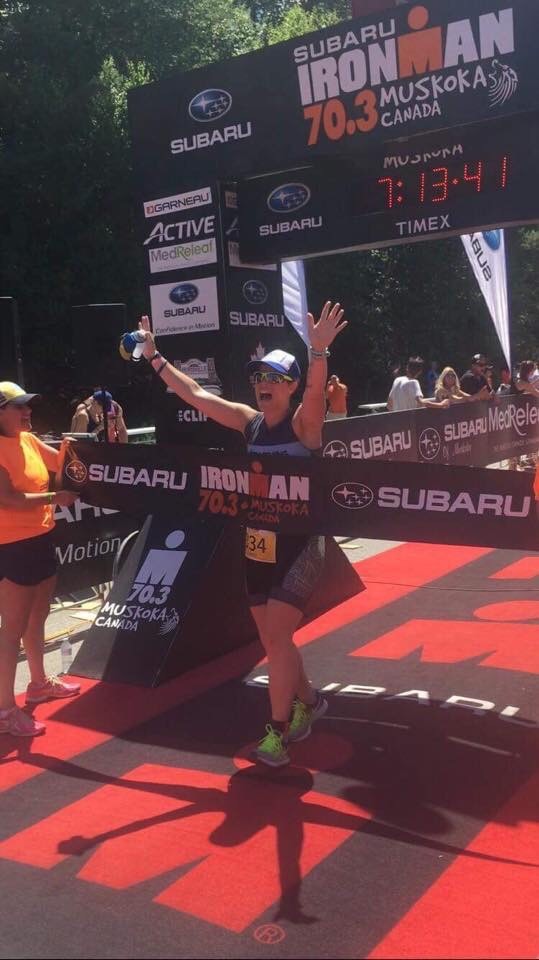 Casey Kidson-Reid, DMRF Canada's Dystonia Ambassador, has had an incredible athletic journey. She continues to 'dyfy' dystonia by swimming, biking, and running towards many achievements both athletes and non-competitors alike will admire in awe. On September 29th, 2019, she completed her first FULL Ironman in Chattanooga Tennessee, USA that consists of a 2.4-mile swim, 112-mile bike-ride, and a 26.2 mile run.
Casey Kidson-Reid, DMRF Canada's Dystonia Ambassador, has had an incredible athletic journey. She continues to 'dyfy' dystonia by swimming, biking, and running towards many achievements both athletes and non-competitors alike will admire in awe. On September 29th, 2019, she completed her first FULL Ironman in Chattanooga Tennessee, USA that consists of a 2.4-mile swim, 112-mile bike-ride, and a 26.2 mile run.Casey has taken on more challenges and new roles!
- Casey and the Kingston Dystonia Support Group hosted a Freedom to Move for Dystonia walk event on July 16th at CaraCo Track.
- Casey facilitates support group meetings in Kingston, click here to visit the page. She is also a member of the DMRF Canada Board of Directors.
- In September 2020, Casey created a series of exercise videos aimed at the dystonia community! Watch here.
- Casey joined the 2021 Do it For Dystonia Campaign by organizing Spinning for Dystonia - free virtual spin classes throughout February and March 2021. Click here to view Casey's Campaign on Canada Helps.
- She completed her first Ultra Marathon 50k at the Virtual Ottawa Race Weekend! She fundraised with a Five for $5 campaign (a virtual high five with a $5 donation to DMRF Canada). You can check out Casey’s campaign here.
- She has launched a podcast series titled Dyfy The Storm.
- She is an ambassador for Chronically Badass
- The Dyfying Dystonia Campaign will continue to raise awareness of and support for dystonia. Click here for a personal video message from Casey to learn more about the goals she hopes to achieve in order to encourage others in the dystonia community.
Follow Casey on Facebook by clicking here to keep up with her training journey. You can also support her inspiring campaign to 'dyfy' dystonia by making a donation below.

Special thanks to The Davies Charitable Foundation for their support of Kingston initiatives.
Past awards and articles:
Casey Kidson Recognized as the 2017 Change-Maker by NHCC- Jodie Wigle - Reimaging the World in Miniature: Art through the Lens of Dystonia
In an average-sized apartment in Toronto, there’s a tiny kitchen. In that tiny kitchen is an even tinier fridge, its door stocked with miniature condiments and a tray containing raindrops of ice. Its shelves hold a diminutive feast: a head of lettuce shrunk to less than the size of your thumbnail, an onion fit for an ant and a steak in pint-sized cellophane packaging. Holding this world comfortably in the palm of her hand is its creator, miniature artist, Jodie Wigle.

Jodie, 24, is a student at Toronto Metropolitan University, completing her degree in Creative Industries. Her education isn’t what inspired her to begin creating miniatures, it was her disability. As long as Jodie can remember, she struggled to hold her hands steady, constantly dropping things and drawing in shaky lines. By the time she was 11, Jodie had a diagnosis for these difficulties: myoclonus dystonia. Jodie is one of many members of her family who experience symptoms of dystonia. For her, it presents as tics and tremors in her hands.
In 2021, Jodie started making miniatures as part of her artistic expression. “I was seeing a lot of videos on social media of people making miniatures...so I just literally sat down and started making one,” she explains. While many may think they’re lacking the materials, Jodie’s understanding of her fine motor abilities made her keen to start with just cardboard from an Amazon box and acrylic paint. She explains that the stiffness of the cardboard makes it more forgiving and easier for her to steady her hand. “I'm still not great with clay because I think with dystonia, I'll hold it too much and I'll accidentally squish it.”
An important aspect of Jodie’s work is that all her miniature scenes contain pieces that can be picked up, examined and moved around. Jodie’s vision is to have the opportunity to share her miniatures with larger audiences, whether that’s through social media or even better, a gallery exhibit. She wants audiences to be able to interact with them and appreciate them as well as to illustrate that nothing is really fixed in place and steady, just like in life. Along with that sentiment, the dynamic nature of her dioramas is a tribute to the flexibility and adaptability she sees is necessary for living with dystonia or other disabilities. “I want it to be more okay for us to have to reroute instead of being upset at ourselves for breaking something. If you break something, I’ll remake it. It’s okay.”

The process of being able to create for Jodie, is tied to her experience of thriving with dystonia. “Instead of asking why am I the different one, I focus on the ways I can adapt so I have the opportunity to create, which brings so much happiness to everybody.”
Thank you to Jodie for sharing her wonderful works of art with us and we’ll look out for her work in the future!
Paroxysmal Dystonia and Dyskinesias
Muscle groups affected: hands, upper body, or lower extremities
- Jason Young: Loving the Person That I am
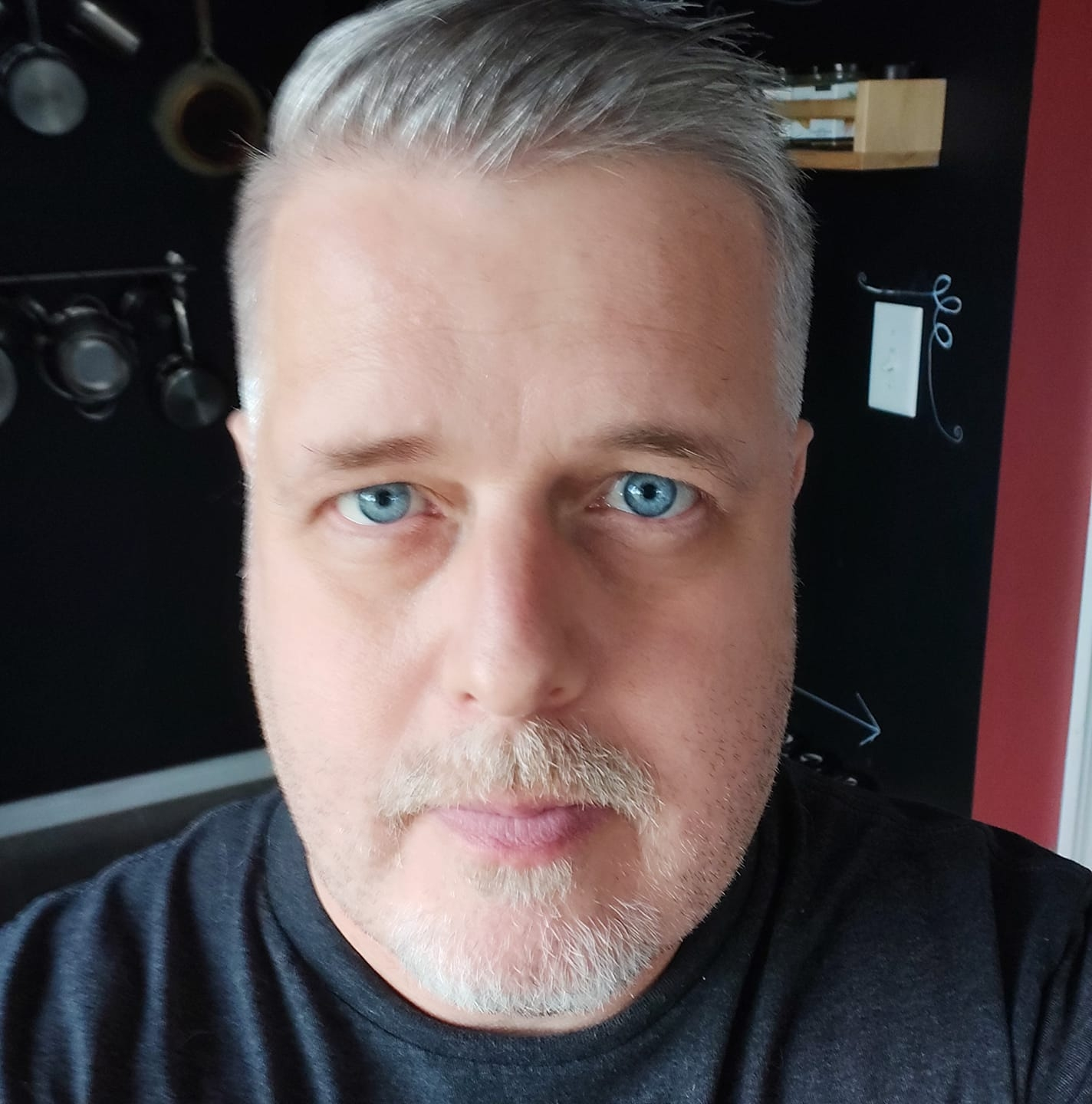 My journey began when I was 25. I was working two jobs and was a volunteer firefighter. I enjoyed camping, golf and loved sports, having played many sports throughout my life with no issues.
My journey began when I was 25. I was working two jobs and was a volunteer firefighter. I enjoyed camping, golf and loved sports, having played many sports throughout my life with no issues.In Fall 1999, soon after waking one morning, I felt a sensation of somebody tugging and pushing on my face. Gradually, the feeling moved to my arms and legs. Concerned, I had my future wife, Amber, take me to the ER, where the doctor told me it was stress and to go home and sleep it off. After I convinced him that it wasn't stress, he told me it was likely drug-induced but agreed to try to help by giving me an Ativan, which eventually stopped the posturing.
Concerned, I pushed for some tests and had the great fortune of seeing a young, intelligent neurologist, who diagnosed me with Paroxysmal Non-Kinesiogenic Dyskinesia (PNKD).
For 11 years, my PNKD remained consistent. My episodes were typically every 3-5 days, a headache within 24 hours before an episode, and I would always feel an aura leading up to the episode.
Then, in late 2011 to early 2012, there was a drastic reversal in my symptoms. My body began developing tremors. These were new to me as they weren’t the tight, twisting, painful postures I was used to. They were constant, tiring movements that lasted for hours until multiple doses of medication forced me to sleep.
Over the next few days, this continued as we couldn’t see a doctor as my diagnosing neuro had moved to another location, and I was unaware that I was without a neurologist. These failed attempts saw medical staff call me a drug addict, an alcoholic, and a liar. Even though I was previously diagnosed, they refused to even ask a neurologist to take a look at me.
After another couple of days, a sharp paramedic finally got me admitted. Five weeks later, I was released and prescribed a 14-pill-a-day regiment.
I have since fought hard to gain as much of my life back as I can. I no longer drive, or golf or play other sports, but as a stay-at-home dad, I have been blessed to watch my amazing daughters grow up.
The experiences I have gone through are all too common for Dystonia patients, which is why I focus hard to raise awareness. As patients, it is our responsibility to help ourselves and those traveling the road behind us.
Awareness leads to research. Research leads to better treatments, and faith willing, a cure.
I am learning to mourn the person I was, which has allowed me to accept and love the person that I am.
Read more about Jason in this interview with DMRF Canada in 2017.
Read about Jason's significant contributions to Dystonia Awareness Month in 2020, 2021, and 2023.
Read Jason's 10 tips to build your support network.
Oromandibular Dystonia (Cranial Dystonia)
Muscle groups affected: face, jaw, and/or tongue
- Thomas Wade: Juno-nominated Country Music Artist
Thomas Wade was already the successful lead vocalist of an award-winning country-music band, an accomplished songwriter, and emerging solo artist when he was diagnosed with Oromandibular Dystonia, a neurological disorder that affects speech. Thomas noticed troubling symptoms affecting his vocal cords when his band, Thomas Wade and Wayward, was achieving domestic success on the Canadian charts. Their path towards national recognition was fully realized when Thomas Wade and Wayward secured three Juno nominations and seven Canadian Country Music Association awards from 1997 through to ’99.
Thomas’ success on the national charts was a big leap from his small-town roots in Burford, Ontario. He came from a musical family and was surrounded by diverse musical influences in his childhood. At age four he learned how to play guitar, at the age of six he began performing in front of live audiences and at the age of seven he penned the first of many songs, sitting on his back porch.
He moved towards bigger goals with his family band, Silver Wings, a popular dance band in the Brant County area. By the time he had graduated from Fanshawe College with a degree in music production, he was lead singer of Thomas Wade and Wayward and on tour. He sought more challenges and expanded his skills in music.
Thomas and his band looked towards the international market when nation-wide fame became a reality. At this point, however, his vocal cords had started to fail him, but he didn’t know why. Despite acquiring a vast skill set in music, his voice was the critical element in helping him to launch his successful career in music.
For years, Thomas struggled with vocal difficulties. At first, his ability to sing seemed to slip away gradually, then completely for reasons vocal coaches and doctors couldn’t explain. He was forced to struggle through shows, hoping for some kind of a solution. But eventually he had to give up as he was unable to sing at all. It was devastating to lose not only the career he had built over a lifetime, but integral part of his identity. Then, over the next two years he slowly lost control of his tongue and his jaws severely affecting his speech.
By the time Thomas received an official diagnosis that could help him understand what was affecting his voice, he could no longer speak. Along with an official diagnosis, doctors let him know that Oromandibular Dystonia is incurable.
When confronted with the possibility that he might never speak or sing again, Thomas made a crucial decision in his life: to learn as much he could about the brain. He was determined to defeat his dystonia rather than let it rule him. Thomas learned about neuroplasticity, a ground-breaking technique that enables the brain to reorganize itself. He explored hypnosis, and even formulated his own exercises, using the principles of neuroplasticity to recover his speech and voice. By 2011, five years after his official diagnosis, he was able to sing and speak again.
In the years between when he noticed difficulties with his voice and an official diagnosis, Thomas turned his attention towards writing and producing, focusing on what could be done with the gifts he still had rather than direct his efforts towards what was out of his control. During these years, he wrote for other artists, developing a successful writing career. Once he had gained the use of voice again, he decided that he wanted to approach music with a new sense of discovery and appreciation rather than chase the next upward trajectory in his career.
Instead, Thomas felt drawn to recapture the love of music that had inspired him to become a singer in the first place, creating an album of music that echoed the sounds that had called him to a life in music - in essence, Thomas says, he decided to “follow the love”. The result was a classic album and a triumphant return with the album, “Blue Country Soul”.
Through hard work, determination, and tremendous effort, Thomas has continued to pursue music with a different vision of where he’d like to take his writing and singing. From where he now stands in music and in life, he hopes to share his story with others with his first book, a chronicle of his journey through dystonia, called “Singing in my sleep”.
“Dystonia in even one finger can end a musician’s career. How many musicians have simply disappeared because of Dystonia. More than you know. I was one of them.” - Thomas Wade.
Learn more about Thomas Wade and his book here.
Click here to read about Thomas Wade as the 2020 Dystonia Ambassador for Chuck's 5KM Virtual Run, Walk and Wheel for Dystonia.
Dystonic Gait Disorder
- Anna McNabb: There Is No Such Thing As Impossible
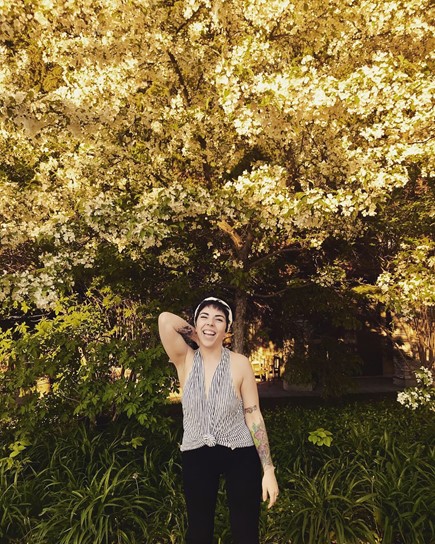 Growing up in the small cottage town of Collingwood, Ontario, Anna McNabb, noticed early on that she wasn’t like other children. At three, “I was beginning to walk with a limp, more prominent on my left side. Stumbling and falling became a way of life for me, and shortly thereafter, I required assistance doing many everyday activities.” Anna’s mother, Maria Dickey, was puzzled by her symptoms. Anna’s family thought they had found their answer when she was diagnosed with cerebral palsy at age six. For the next eighteen years, Anna and her family lived her with her misdiagnosis.
Growing up in the small cottage town of Collingwood, Ontario, Anna McNabb, noticed early on that she wasn’t like other children. At three, “I was beginning to walk with a limp, more prominent on my left side. Stumbling and falling became a way of life for me, and shortly thereafter, I required assistance doing many everyday activities.” Anna’s mother, Maria Dickey, was puzzled by her symptoms. Anna’s family thought they had found their answer when she was diagnosed with cerebral palsy at age six. For the next eighteen years, Anna and her family lived her with her misdiagnosis.Due to her deteriorating mobility, Anna was told by doctors to live life while she still could - as eventually she would be wheelchair bound. “I endured pain to be able to participate in equal experiences to my friends. I denied that my life had to slow down, I did everything I could to prolong my independence. Sadly, at 18, I required assistive devices and spent much of my college freshmen year in a hospital instead of a dorm room” Anna shared.
Despite her challenges, Anna forged ahead. She met her future husband, a military man, and was touched that he never asked her what was “wrong” with her. They soon married, and her husband took over the role of caregiver from her family. She needed assistance with everyday tasks including getting into bed, bathing, and even blow drying her hair. Despite reassurances from her loved ones, Anna felt like a burden.
After 18 years of living with cerebral palsy, Anna’s diagnosis didn’t seem the correct fit, according to her mother, Maria. Determined to find a more accurate diagnosis, Maria pressed for doctors to re-examine Anna, looking for new opinions on her symptoms, and new available treatments. Maria proposed that Anna could be suffering from a rare movement disorder that she had read about- dystonia. After booking an appointment, Anna vowed not to seek another diagnosis, “if [the results are] inconclusive, I will live as I can and deal with the pain caused by my limited mobility.” The doctor ordered a blood test and results confirmed Anna and Maria’s suspicions; Anna had dopa-responsive dystonia.
Following her new diagnosis, Anna was placed on two new medications, instead of the sixteen she was taking previously. Within three days, Anna says that she could now “wobble” around with ease and notes that, this was the first time her husband had seen her walk without assistance.
Now living in Edmonton, AB, Anna leads a thriving life. She owns a small business and lives life on her own terms. She said it took time and physical rehabilitation to adjust to living with dystonia, but now, Anna says, “everyday I wake up to a completely new opportunity with a fraction of the previous pain and a completely changed sense of independence.” Anna now lists her favourite hobbies as hiking, snowshoeing, and bike riding. This is a world of difference from the life doctors told her to expect as an adolescent.
Anna is grateful for the support and community she found through DMRF Canada: “through their constant support including online seminars, information bundles, and online community, I am able to live my life to its fullest. I don’t take for granted the independent life that I am able to have now. Opportunities that would have been challenging before are now well within my grasp. I guess that means I’ll just have to keep reaching, and I hope the same for everyone else. People should never stop believing that life can be more. There is no such thing as impossible, I am proof of that.”


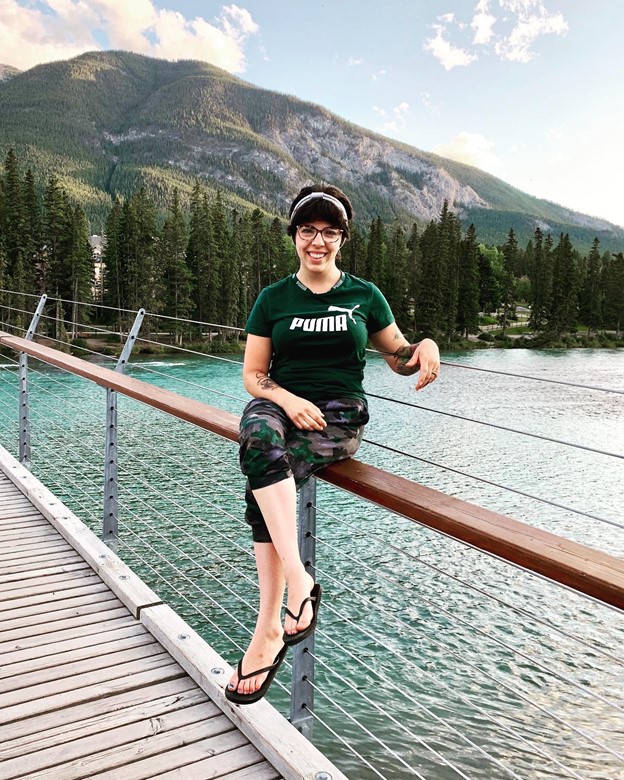
Tardive Dyskinesias
- Living a Full Life With Tardive Dystonia
Watch/Listen to Stories of How Persons are Thriving with Tardive Dystonia
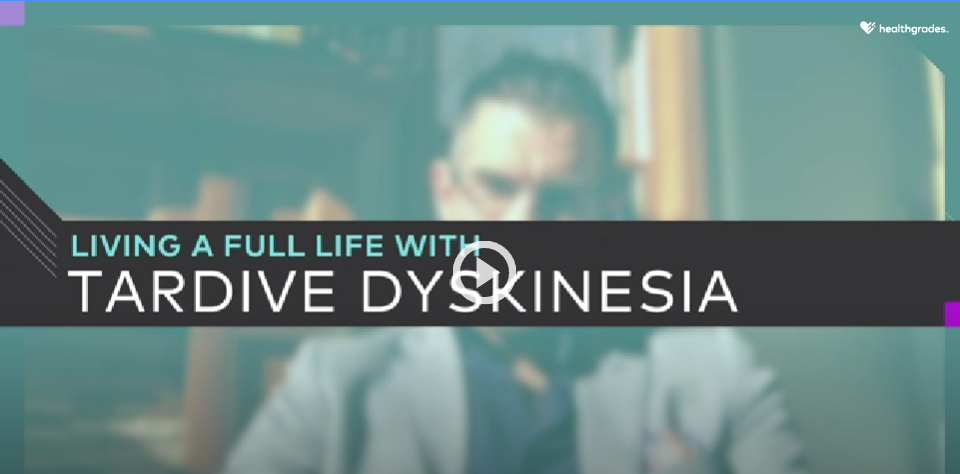
Other Stories
- Yann: Twisted Talk
Meet Yann, the co-founder of Twisted Talk, based in Montreal. Here is his story on his battle with Dystonia.

"I was diagnosed with dystonia in October 2017. I had started to experience my symptoms a few months earlier, and at that time no one was able to confirm what my strange painful condition was.
After I finally heard the word dystonia my head was spinning, I wasn`t too sure what to think about my diagnosis. It was a combination of relief, knowing that I knew what I had - and also sadness, knowing that from now on everything would be different. Soon after, I went to a francophone group meeting in Quebec. It was nice to see other people with my condition and it was a nice opportunity to get to know more about dystonia. Soon after the Leader of the French group mentioned that they were looking for someone to start an English support group in Montreal.
I got in touch with DMRF and I found out that there was another person (Jade) who wanted to start a group as well. Together Jade and I came up with the idea of Twisted Talk. We started to work together to reach out to Anglophone people in Montreal who have dystonia.
At first, it was a challenge to reach the Anglophone population in Montreal with dystonia. But soon I started to hear from patients with dystonia. All people with different stories, some who had just recently been diagnosed, some who had never been diagnosed and didn’t know what to do, and some who had been living with dystonia for years. As of today, we are a small group, but I am glad that Jade and I worked with DMRF to make Twisted Talk happen. I have met extraordinary people and we have helped some to see the right specialist in Montreal. It's really rewarding to give back in that way.
My advice for others who have dystonia? It takes bad days to have good days, don’t be ashamed of what you have, and do everything you can do to get better. Every day we fight, and this is what makes us dystonia warriors."
To learn more about Twisted Talk and upcoming events, email: twistedtalkmontreal@gmail.com
- Jade Willshaw: Accept and Love Your Dystonia
Meet Jade Willshaw, the co-founder of "Twisted Talk", based in Montreal. Here is a transcript of a sit-down we had with her in 2019, where she shares her thoughts on living with Dystonia.
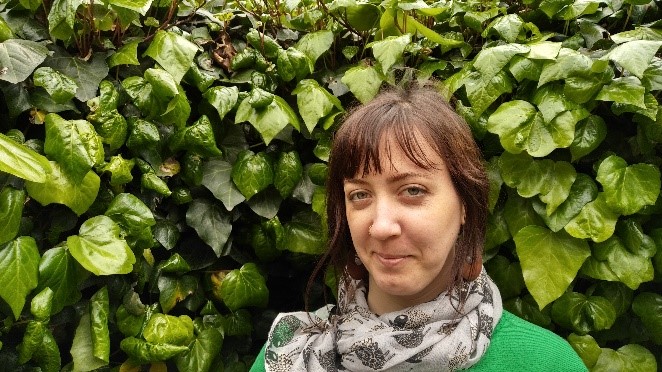
DMRF: Hi Jade! Thanks for sitting down with us to tell us a little bit about your dystonia story. First off - how long did it take you to get your dystonia diagnosis?
JW: It took several years before I knew what dystonia was. Because I have secondary dystonia from a stroke that happened early on in my life, the dystonic symptoms were an unknown movement disorder.
DMRF: What was your first thought after you were diagnosed?
JW: It was interesting to finally define and name my spasticity as dystonia. I thought, what is this dystonia? How many other people does it affect?
DMRF: What has made you decide to get involved with DMRF Canada as a volunteer Support Group Leader?
JW: I have always been an advocate for helping others and wanted to be involved in the dystonia community. I wanted to connect others together so they could share a mutual conversation about living with dystonia. Since there was a lack of support for English-speaking patients in the Montreal community, I decided to take on the role of Co-Leader, along with Yann Rondeau, and together we created “Twisted Talk”. Yann and I are working on creating a cohesive group that instills comradery, acceptance, and support. It is still in the early stages, but we have high hopes for hosting guest speakers to talk on managing and living well with dystonia in the near future.
DMRF: If you could describe dystonia in one word, what would it be?
JW: Resilience. Dystonia is a daily challenge and brings awareness to the perspective of life's true significance.
DMRF: What has your dystonia taught you?
JW: Patience, acceptance, and empathy. I am patient with myself and respect my own limits, especially in the fast-paced world we live in. I find myself 'dancing to my own tune'.
DMRF: If you could give others out there one piece of advice, what would it be?
JW: Have patience with yourself and respect your body. Accept and love your dystonia. It does not define who you are, but it is nonetheless a part of you.
- Claire Smith: I Now Dance Through Life
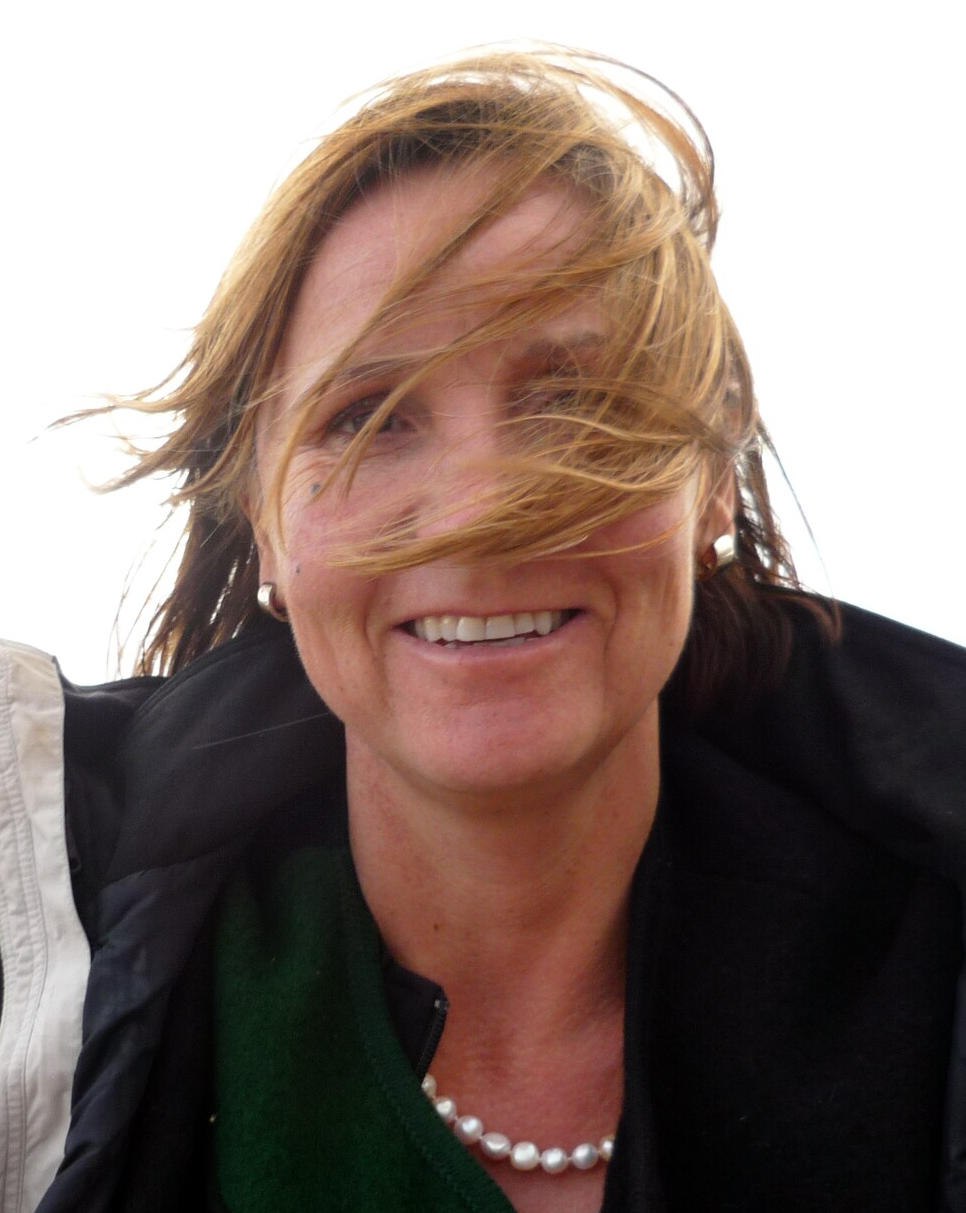 Dystonia, a consequence of a life-changing head injury, has been resident in my right leg for almost ten years. I wear a brace that conspicuously covers my entire leg: it only fits over my pants. It’s been quite a journey since the time when, over nineteen years ago, my life instantly changed.
Dystonia, a consequence of a life-changing head injury, has been resident in my right leg for almost ten years. I wear a brace that conspicuously covers my entire leg: it only fits over my pants. It’s been quite a journey since the time when, over nineteen years ago, my life instantly changed.On September 13th, 1997, I sustained a severe traumatic brain injury when I fell from my horse while competing on the Canadian Equestrian Team at the European Championships. After six months in hospital, followed by a year of rehabilitation, I denied the harsh reality that things could no longer be as they had been. I moved to North Carolina, where I’d spent the winter months with my horses.
Things would be the same, would they not? It took over a year for me to realize that I could no longer live life as it had been. I found a new goal when I enrolled in university in the fall of 2000. To fulfill the requirements for a Masters of Arts, I conducted a study exploring the impact of engaging in creative activities on the self-esteem of survivors of head injury.
Graduating in the spring of 2004, I headed straight into the Ph.D. program. But, in 2006, I started to drag my right foot. However, it wasn’t until 2008 that the doctors diagnosed Dystonia. By then, my right knee was locked. During data collection for my Ph.D. study, which examined the identity construction of athletes who’d sustained head injuries, my walk progressively worsened. I defended my Ph.D. thesis in a wheelchair.
When I finished the Ph.D., I finally had space in my head to emotionally confront Dystonia. Although the accident in 1997 will forever colour my life, I was well on the way to healing any lingering emotional damage when, several years after the fall, the chronic illness Dystonia re-infected those psychological wounds. It was much worse the second time around, but the sores have now scarred and are rock solid under my emotional feet.
Although I now dance through life, I realize that the wounds may fester again if given the opportunity, once again becoming unchecked. Dangerous. Only time will reveal if the healing is but tenuous. Using a wheelchair just means that my ‘normal’ is different than it once was. For me, ‘normal’ means I’ve adapted to my losses and have found ways to work around them. I glide through life once more: metaphorically, emotionally, and physically. I have fashioned my life so that I feel one and the same as able-bodied others. I really don’t believe that I’ve let Dystonia carve me into pieces.
Dystonia will always lurk menacingly in my life’s shadows, but I refuse to give it the satisfaction of letting its presence affect me, even though the wheelchair makes its consequences visible to all. Sure, life would be a lot easier without Dystonia as part of it, but at least I was able to leave behind the emotional anguish that Dystonia once was.
Claire has recently published a book that chronicles her life story, and her injury. Find more information here: www.clairesmith-author.ca
- Jesse Arrigo: Connected By Love
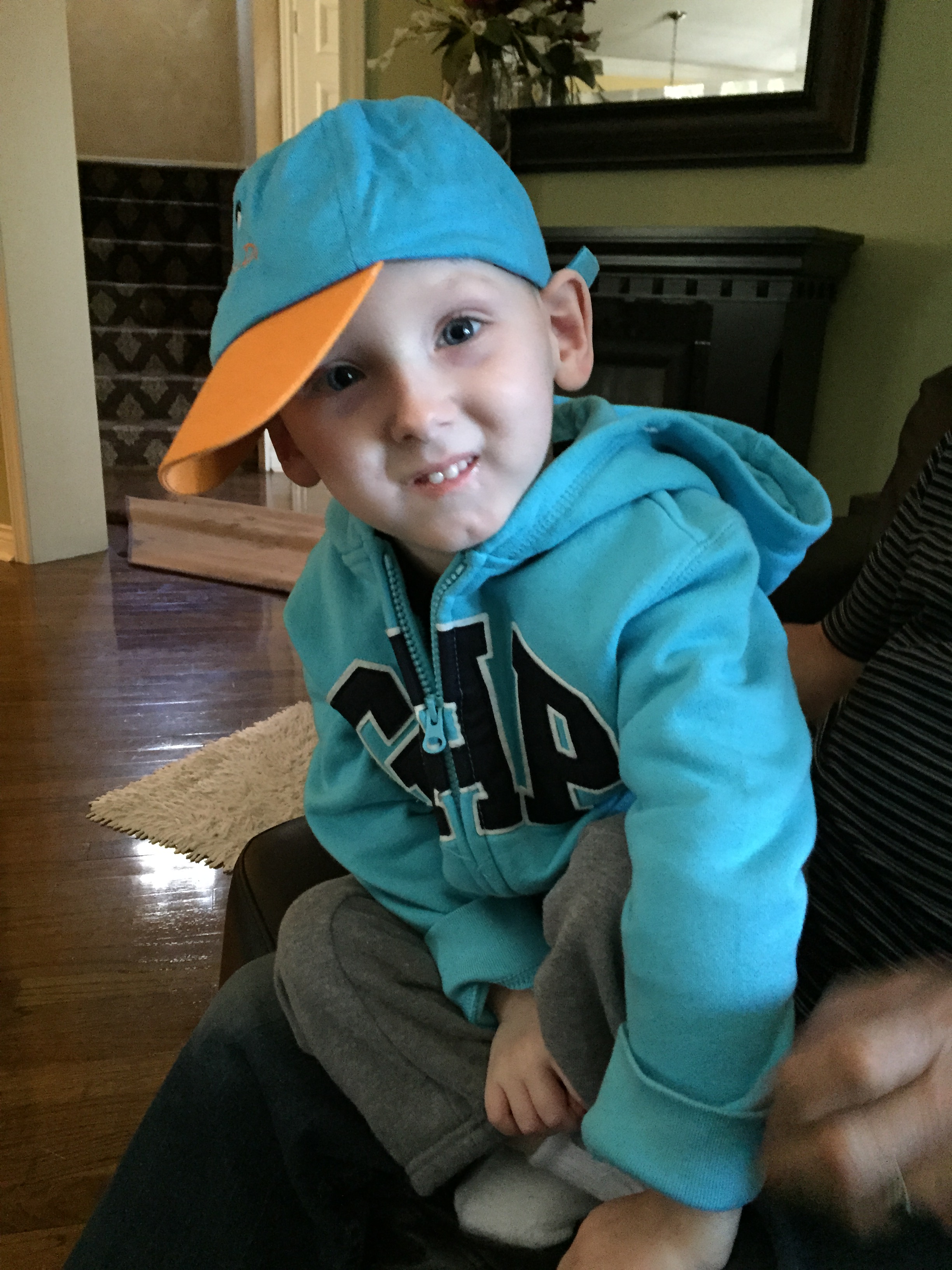 Each year, the DMRF Canada selects an individual to be represented at the 2016 Chuck’s Run 5 km Walk/Run Event, held at High Park in Toronto. We are pleased to introduce Jesse Arrigo, a very special boy, and an inspiring Ambassador - who just happens to have a special connection to Chuck Saundercook.
Each year, the DMRF Canada selects an individual to be represented at the 2016 Chuck’s Run 5 km Walk/Run Event, held at High Park in Toronto. We are pleased to introduce Jesse Arrigo, a very special boy, and an inspiring Ambassador - who just happens to have a special connection to Chuck Saundercook.Written by: Bob Arrigo, Jesse’s Grandfather
I am writing this story from my perspective as a grandfather. I currently have three grandsons and the one I write about today is about to turn five years old. His story though has deep roots that seem to dig back through several decades. You see when I was a boy my family lived next door to the Saundercook family. We shared a semi-detached home separated only by a thin centre wall. We lived almost like one big family. An open gate through our back yards and our front doors always open to each other.
The Saundercooks were a family of nine children. One of them was different from the rest. His name was Chuck. At an early age Chuck developed a condition called Dystonia. Back then none of us had heard the term before. As the years passed we all helplessly watched dystonia take a progressively greater hold on him. As I approached young adulthood, fell in love and got married, I have a wonderful memory of my new bride and I on each side of Chuck in his wheelchair, him giving us his thumbs up. It was Chuck's way of giving the big okay to our union. Shortly thereafter - at age sixteen, pneumonia finally took Chuck’s life – due to his weakened state as a result of his dystonia.
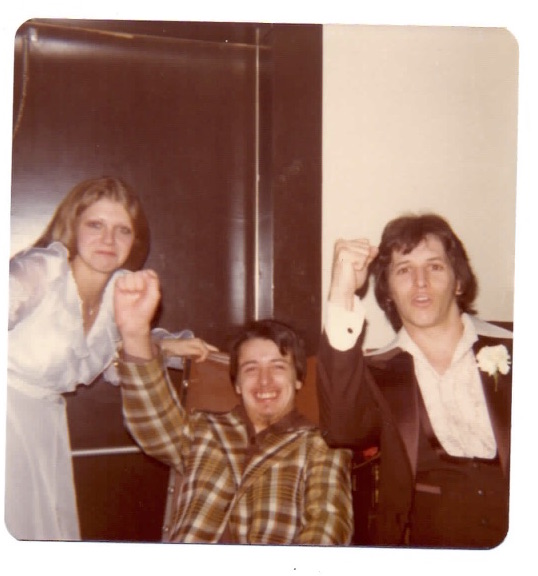
Joanne and Bob Arrigo with Chuck Saundercook
As the years passed my wife and I brought three children into the world. As a young adult our eldest daughter Kristin had a cancer scare and had to have half of her cervix removed. She wrestled with the fact that chances of her ever conceiving a child of her own were slim to none. But a day eventually came, much to her surprise and ours that she conceived. It was like a miracle in the making. Nine months later Kristin bore a son. She named him Jesse, which means "Gift of God."
Jesse was a very advanced child through all stages of his infancy and due to Kristin's difficult pregnancy Jesse was developmentally tested several times for his physical and cognitive status and he scored at the 97%+ level. This was a child who shocked us every week with how fast he was learning. At eight months old after crawling for a couple of weeks, he stood to his feet. At nine months he walked from couch to table to ottoman, and at ten months he let go of everything that could hold him back and set out to discover the world.
On May 17th, 2011 in a momentary lapse of our attention Jesse discovered the swirling colours beneath the waters of our Koi pond and instantly found himself fighting for his life. Drowning is a silent death. It isn't an experience full of screaming and shouting for help. An infant's lungs will fill with water in 30 seconds and silence any call for help. Even with an adult drowning, arms are not waving in the air as depicted in the movies, they are below the surface pushing down on the water in a futile and desperate attempt to find air above the surface.
Within a moment Kristin pulled Jesse from the water and began CPR on his lifeless body. Jesse was in full respiratory arrest. Paramedics arrived and continued CPR for 45 minutes before transporting him to emergency where hospital staff continued CPR and multiple medications for fifty-five minutes. It would be four more hours and the survival of two cardiac arrests until he would be stable enough to transport him to Toronto's Sick Kids Hospital. The prognosis was his certain passing before morning. Jesse miraculously survived the night and has survived every life threat since including double pneumonia. In our weeks at Sick Kids Hospital we learned that due to Jesse’s anoxic injury (a deprivation of oxygen to the brain) he had developed dystonia; how our minds flashed back to Chuck in those days and in many days since.
 A traumatic brain injury such as a blow to the head or an accident can effect a part of the brain, but a non-traumatic anoxic injury is a "blanket" injury that effects the entire brain. We were told that when millions of brain cells have died and become nothing more than scar tissue there is no known way to restore what was lost. We grew accustomed to hearing about Jesse's inevitable "constant vegetative state." But due to our faith in God, our great love for Jesse and his undeniable incredible will to live, our family learned to travel way outside the box of traditional therapy for help. Along the way we have learned that the brain like all other organs and muscles in the human body grows by use. We have now logged thousands of hours exposing Jesse to visual, auditory and tactile stimulation and many more thousands in dollars to "wake up" dormant brain cells in an effort to rebuild what was lost.
A traumatic brain injury such as a blow to the head or an accident can effect a part of the brain, but a non-traumatic anoxic injury is a "blanket" injury that effects the entire brain. We were told that when millions of brain cells have died and become nothing more than scar tissue there is no known way to restore what was lost. We grew accustomed to hearing about Jesse's inevitable "constant vegetative state." But due to our faith in God, our great love for Jesse and his undeniable incredible will to live, our family learned to travel way outside the box of traditional therapy for help. Along the way we have learned that the brain like all other organs and muscles in the human body grows by use. We have now logged thousands of hours exposing Jesse to visual, auditory and tactile stimulation and many more thousands in dollars to "wake up" dormant brain cells in an effort to rebuild what was lost.It has been four years since Jesse's accident and his jaw dropping progress has taken many in the medical community by surprise. He still cannot walk although his is learning to crawl. He cannot talk, at least in a language that you could understand, but our family is well aware of what he is expressing in the few simple words he has learned and through his own developed communication skills. And now - three generations later- the Arrigo and Saundercook families have been reunited once again by our mutual love for each other and a common adversary.
Though we feel Jesse's full purpose has yet to be realized, it has fallen now to Jesse, the possibility to contribute one more piece to this puzzle. Though much has been overcome in his five short years, his biggest challenge remains, and it's called Dystonia.
- Jackson Mooney: An Exercise In Humility
My Life with Dystonia: Jackson Mooney, Vancouver Dystonia Support Group Leader
Over 50,000 patients in Canada suffer from dystonia, a neurological movement disorder that affects the nervous system. Abnormal signalling from the brain causes muscles to tighten and twist involuntarily. There are several forms of dystonia, and dystonia may be a symptom of many diseases and conditions.
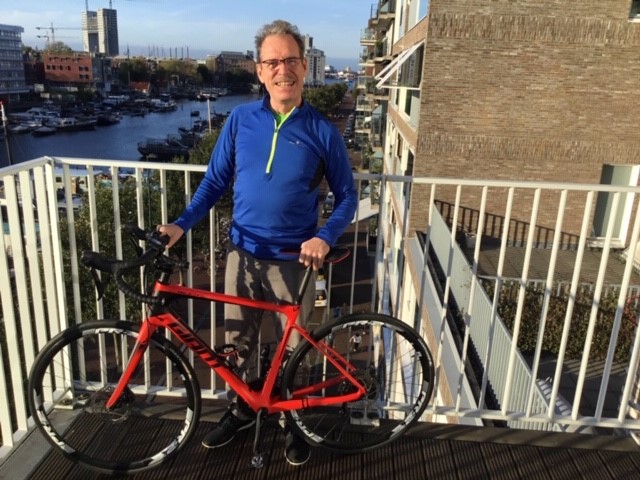 My journey with dystonia began with a diagnosis prior to any conscious recognition of symptoms. I had had a C5 nerve root for which I was referred to a neurologist. While he examined me, he asked why my head turned when I closed my eyes. He immediately referred me to the Movement Disorder (MD) Clinic at the Glenrose Hospital in Edmonton.
My journey with dystonia began with a diagnosis prior to any conscious recognition of symptoms. I had had a C5 nerve root for which I was referred to a neurologist. While he examined me, he asked why my head turned when I closed my eyes. He immediately referred me to the Movement Disorder (MD) Clinic at the Glenrose Hospital in Edmonton.The symptoms appeared gradually about 15 years ago. They finally progressed to a point where 400 units of neurotoxin was failing to accomplish any relief. I decided to opt for Deep Brain Stimulation (DBS) surgery in early February 2014. Initially, I had very little relief from the surgery. In fact, when the unit was turned on, my body mimicked symptoms of Parkinson’s Disease. Despite some gradual benefit from the DBS, I found I could no longer work in any concerted way and had to shut down my business.
Dystonia has been a great teacher! It has been an exercise in humility and recognizing my “powerlessness” in many aspects of my life and around me. It has also taken me a great deal of time and acceptance to stop caring about how I appear to other people.
I try to be as involved as possible with the dystonia community. My brother and I established the Jackson Mooney Patient Grant in 2017, to help those living with dystonia obtain the education and/or retraining needed to pursue a vocation and to meet the requirements of the duties involved. Thanks to the determination and passion of a neurologist, Dr. Silke Cresswell, I was involved in her focus group for the new Brain Wellness Centre at UBC.
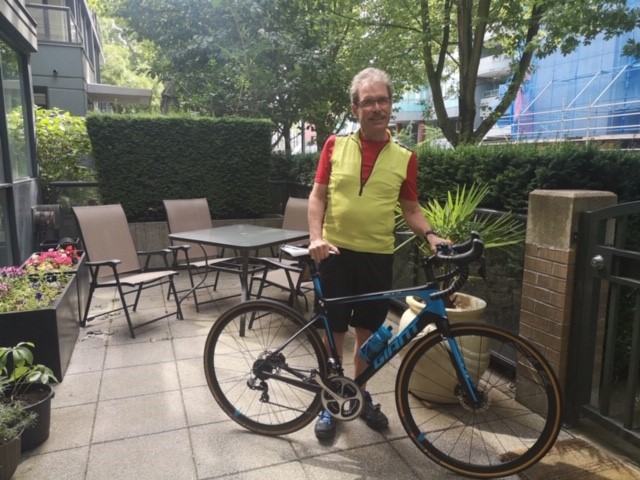 The greatest need of the dystonia community besides improvements in awareness and treatments; is connecting with others. I suspect there are many who either do not have a diagnosis or have been diagnosed and have given up. I have met very few people who have dystonia. When I moved to Vancouver, I wanted to connect with others in the community. By doing this, I gained a great sense of relief in knowing I was not alone. Robin (support group co-leader) and I both shared tears of relief and joy when we first connected.
The greatest need of the dystonia community besides improvements in awareness and treatments; is connecting with others. I suspect there are many who either do not have a diagnosis or have been diagnosed and have given up. I have met very few people who have dystonia. When I moved to Vancouver, I wanted to connect with others in the community. By doing this, I gained a great sense of relief in knowing I was not alone. Robin (support group co-leader) and I both shared tears of relief and joy when we first connected.The Dystonia Medical Research Foundation (DMRF) Canada is the only organization that is dedicated to supporting the dystonia community in Canada. If you or someone you know is struggling with dystonia, you’re not alone.
*Jackson’s story was published in the UBC e-newsletter to promote the 2019 Vancouver symposium and dystonia awareness.
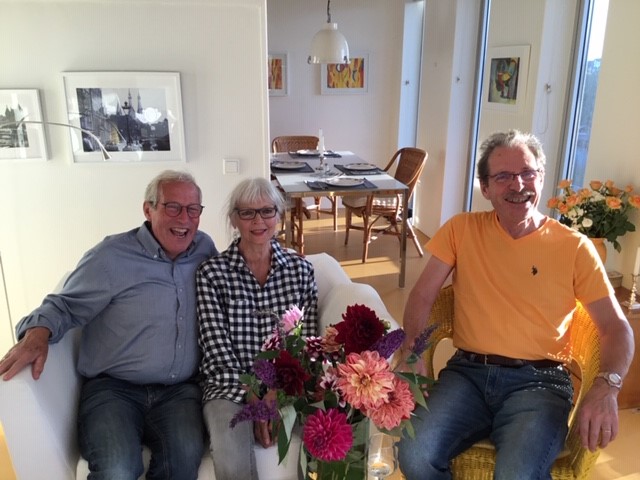
- Jacqueline Bell: I Am Grateful For My Life
Jacqueline Bell's moving story is available as a PDF here.
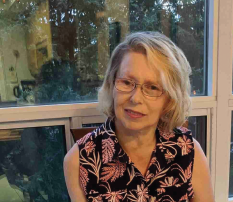
- Meghan Fell -Living in Harmony with Dystonia

How Meghan Fell finds community, opportunity and joy in music
Meghan Fell is a self-described “raging extrovert.” Broad smile, sense of humour, and natural performer energy. Before acquiring dystonia secondary to a stroke at age 13, she played multiple instruments and sang. Dystonia on her left side meant piano, French horn, and guitar—her left‑handed instruments—were no longer possible. She continued with voice lessons.
Meghan built a career in marketing, communications, and fundraising. After she married and had her son, the energy required for full-time work outside the home wasn’t sustainable alongside family life and dystonia. Looking for a creative outlet, she joined the women’s a cappella show choir Lions Gate Chorus—an 18‑year weekly commitment that’s brought travel, community, and joy. Highlights include winning the 2024 Sweet Adelines World Championships, an appearance on Canada’s Got Talent, and major performances.
Because her left side doesn’t always cooperate, Meghan adapts choreography, consulting with the group’s choreographer to ensure modifications fit the vision. She also performs from a riser chair so she’s level with her fellow performers.
Singing and performance nourish her social and emotional well‑being: “It fills my bucket, fills my soul.” Regular rehearsals provide structure and an essential outlet. She’s become highly aware of posture, tension, and breath; the focus required for singing often eclipses attention on dystonic movements.
The consistency of weekly rehearsals keeps her grounded: “There are people counting on me. I’m going every Tuesday. I’ve been in the chorus for 18 years and I’m showing up for myself.”
If you’re interested in exploring the benefits of music for dystonia, DMRF Canada highlights free Neurologic Music Therapy sessions through the University of Toronto and other community resources on our events page (see Community Education & Impact).
Source: Dystonia Canada Report – Fall/Winter 2025, p. 16. Adapted for web/print accessibility.
Thank you to Dystonia Medical Research Foundation (USA) for allowing us to share the information and patient stories on Tardive Dyskineasias. The DMRF is a 501(c)(3) non-profit organization dedicated to advancing research for improved dystonia treatments and ultimately a cure, promoting awareness, and supporting the well-being of affected individuals and families.
